Collaborative and usage-driven evolution of personal ontologies
- 格式:pdf
- 大小:135.87 KB
- 文档页数:7
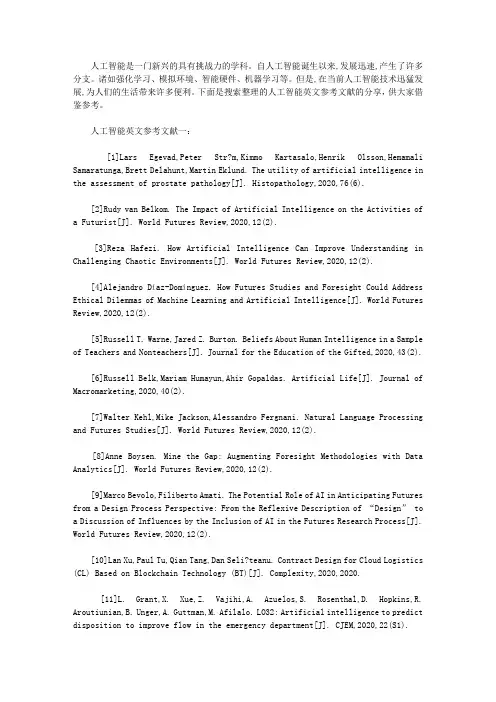
人工智能是一门新兴的具有挑战力的学科。
自人工智能诞生以来,发展迅速,产生了许多分支。
诸如强化学习、模拟环境、智能硬件、机器学习等。
但是,在当前人工智能技术迅猛发展,为人们的生活带来许多便利。
下面是搜索整理的人工智能英文参考文献的分享,供大家借鉴参考。
人工智能英文参考文献一:[1]Lars Egevad,Peter Str?m,Kimmo Kartasalo,Henrik Olsson,Hemamali Samaratunga,Brett Delahunt,Martin Eklund. The utility of artificial intelligence in the assessment of prostate pathology[J]. Histopathology,2020,76(6).[2]Rudy van Belkom. The Impact of Artificial Intelligence on the Activities ofa Futurist[J]. World Futures Review,2020,12(2).[3]Reza Hafezi. How Artificial Intelligence Can Improve Understanding in Challenging Chaotic Environments[J]. World Futures Review,2020,12(2).[4]Alejandro Díaz-Domínguez. How Futures Studies and Foresight Could Address Ethical Dilemmas of Machine Learning and Artificial Intelligence[J]. World Futures Review,2020,12(2).[5]Russell T. Warne,Jared Z. Burton. Beliefs About Human Intelligence in a Sample of Teachers and Nonteachers[J]. Journal for the Education of the Gifted,2020,43(2).[6]Russell Belk,Mariam Humayun,Ahir Gopaldas. Artificial Life[J]. Journal of Macromarketing,2020,40(2).[7]Walter Kehl,Mike Jackson,Alessandro Fergnani. Natural Language Processing and Futures Studies[J]. World Futures Review,2020,12(2).[8]Anne Boysen. Mine the Gap: Augmenting Foresight Methodologies with Data Analytics[J]. World Futures Review,2020,12(2).[9]Marco Bevolo,Filiberto Amati. The Potential Role of AI in Anticipating Futures from a Design Process Perspective: From the Reflexive Description of “Design” to a Discussion of Influences by the Inclusion of AI in the Futures Research Process[J]. World Futures Review,2020,12(2).[10]Lan Xu,Paul Tu,Qian Tang,Dan Seli?teanu. Contract Design for Cloud Logistics (CL) Based on Blockchain Technology (BT)[J]. Complexity,2020,2020.[11]L. Grant,X. Xue,Z. Vajihi,A. Azuelos,S. Rosenthal,D. Hopkins,R. Aroutiunian,B. Unger,A. Guttman,M. Afilalo. LO32: Artificial intelligence to predict disposition to improve flow in the emergency department[J]. CJEM,2020,22(S1).[12]A. Kirubarajan,A. Taher,S. Khan,S. Masood. P071: Artificial intelligence in emergency medicine: A scoping review[J]. CJEM,2020,22(S1).[13]L. Grant,P. Joo,B. Eng,A. Carrington,M. Nemnom,V. Thiruganasambandamoorthy. LO22: Risk-stratification of emergency department syncope by artificial intelligence using machine learning: human, statistics or machine[J]. CJEM,2020,22(S1).[14]Riva Giuseppe,Riva Eleonora. OS for Ind Robots: Manufacturing Robots Get Smarter Thanks to Artificial Intelligence.[J]. Cyberpsychology, behavior and social networking,2020,23(5).[15]Markus M. Obmann,Aurelio Cosentino,Joshy Cyriac,Verena Hofmann,Bram Stieltjes,Daniel T. Boll,Benjamin M. Yeh,Matthias R. Benz. Quantitative enhancement thresholds and machine learning algorithms for the evaluation of renal lesions using single-phase split-filter dual-energy CT[J]. Abdominal Radiology,2020,45(1).[16]Haytham H. Elmousalami,Mahmoud Elaskary. Drilling stuck pipe classification and mitigation in the Gulf of Suez oil fields using artificial intelligence[J]. Journal of Petroleum Exploration and Production Technology,2020,10(10).[17]Rüdiger Schulz-Wendtland,Karin Bock. Bildgebung in der Mammadiagnostik –Ein Ausblick <trans-title xml:lang="en">Imaging in breast diagnostics—an outlook [J]. Der Gyn?kologe,2020,53(6).</trans-title>[18]Nowakowski Piotr,Szwarc Krzysztof,Boryczka Urszula. Combining an artificial intelligence algorithm and a novel vehicle for sustainable e-waste collection[J]. Science of the Total Environment,2020,730.[19]Wang Huaizhi,Liu Yangyang,Zhou Bin,Li Canbing,Cao Guangzhong,Voropai Nikolai,Barakhtenko Evgeny. Taxonomy research of artificial intelligence for deterministic solar power forecasting[J]. Energy Conversion and Management,2020,214.[20]Kagemoto Hiroshi. Forecasting a water-surface wave train with artificial intelligence- A case study[J]. Ocean Engineering,2020,207.[21]Tomonori Aoki,Atsuo Yamada,Kazuharu Aoyama,Hiroaki Saito,Gota Fujisawa,Nariaki Odawara,Ryo Kondo,Akiyoshi Tsuboi,Rei Ishibashi,Ayako Nakada,Ryota Niikura,Mitsuhiro Fujishiro,Shiro Oka,Soichiro Ishihara,Tomoki Matsuda,Masato Nakahori,Shinji Tanaka,Kazuhiko Koike,Tomohiro Tada. Clinical usefulness of a deep learning‐based system as the first screening on small‐bowel capsule endoscopy reading[J]. Digestive Endoscopy,2020,32(4).[22]Masashi Fujii,Hajime Isomoto. Next generation of endoscopy: Harmony with artificial intelligence and robotic‐assisted devices[J]. Digestive Endoscopy,2020,32(4).[23]Roberto Verganti,Luca Vendraminelli,Marco Iansiti. Innovation and Design in the Age of Artificial Intelligence[J]. Journal of Product Innovation Management,2020,37(3).[24]Yuval Elbaz,David Furman,Maytal Caspary Toroker. Modeling Diffusion in Functional Materials: From Density Functional Theory to Artificial Intelligence[J]. Advanced Functional Materials,2020,30(18).[25]Dinesh Visva Gunasekeran,Tien Yin Wong. Artificial Intelligence in Ophthalmology in 2020: A Technology on the Cusp for Translation and Implementation[J]. Asia-Pacific Journal of Ophthalmology,2020,9(2).[26]Fu-Neng Jiang,Li-Jun Dai,Yong-Ding Wu,Sheng-Bang Yang,Yu-Xiang Liang,Xin Zhang,Cui-Yun Zou,Ren-Qiang He,Xiao-Ming Xu,Wei-De Zhong. The study of multiple diagnosis models of human prostate cancer based on Taylor database by artificial neural networks[J]. Journal of the Chinese Medical Association,2020,83(5).[27]Matheus Calil Faleiros,Marcello Henrique Nogueira-Barbosa,Vitor Faeda Dalto,JoséRaniery Ferreira Júnior,Ariane Priscilla Magalh?es Tenório,Rodrigo Luppino-Assad,Paulo Louzada-Junior,Rangaraj Mandayam Rangayyan,Paulo Mazzoncini de Azevedo-Marques. Machine learning techniques for computer-aided classification of active inflammatory sacroiliitis in magnetic resonance imaging[J]. Advances in Rheumatology,2020,60(1078).[28]Balamurugan Balakreshnan,Grant Richards,Gaurav Nanda,Huachao Mao,Ragu Athinarayanan,Joseph Zaccaria. PPE Compliance Detection using Artificial Intelligence in Learning Factories[J]. Procedia Manufacturing,2020,45.[29]M. Stévenin,V. Avisse,N. Ducarme,A. de Broca. Qui est responsable si un robot autonome vient à entra?ner un dommage ?[J]. Ethique et Santé,2020.[30]Fatemeh Barzegari Banadkooki,Mohammad Ehteram,Fatemeh Panahi,Saad Sh. Sammen,Faridah Binti Othman,Ahmed EL-Shafie. Estimation of Total Dissolved Solids (TDS) using New Hybrid Machine Learning Models[J]. Journal of Hydrology,2020.[31]Adam J. Schwartz,Henry D. Clarke,Mark J. Spangehl,Joshua S. Bingham,DavidA. Etzioni,Matthew R. Neville. Can a Convolutional Neural Network Classify Knee Osteoarthritis on Plain Radiographs as Accurately as Fellowship-Trained Knee Arthroplasty Surgeons?[J]. The Journal of Arthroplasty,2020.[32]Ivana Nizetic Kosovic,Toni Mastelic,Damir Ivankovic. Using Artificial Intelligence on environmental data from Internet of Things for estimating solar radiation: Comprehensive analysis[J]. Journal of Cleaner Production,2020.[33]Lauren Fried,Andrea Tan,Shirin Bajaj,Tracey N. Liebman,David Polsky,Jennifer A. Stein. Technological advances for the detection of melanoma: Part I. Advances in diagnostic techniques[J]. Journal of the American Academy of Dermatology,2020.[34]Mohammed Amoon,Torki Altameem,Ayman Altameem. Internet of things Sensor Assisted Security and Quality Analysis for Health Care Data Sets Using Artificial Intelligent Based Heuristic Health Management System[J]. Measurement,2020.[35]E. Lotan,C. Tschider,D.K. Sodickson,A. Caplan,M. Bruno,B. Zhang,Yvonne W. Lui. Medical Imaging and Privacy in the Era of Artificial Intelligence: Myth, Fallacy, and the Future[J]. Journal of the American College of Radiology,2020.[36]Fabien Lareyre,Cédric Adam,Marion Carrier,Juliette Raffort. Artificial Intelligence in Vascular Surgery: moving from Big Data to Smart Data[J]. Annals of Vascular Surgery,2020.[37]Ilesanmi Daniyan,Khumbulani Mpofu,Moses Oyesola,Boitumelo Ramatsetse,Adefemi Adeodu. Artificial intelligence for predictive maintenance in the railcar learning factories[J]. Procedia Manufacturing,2020,45.[38]Janet L. McCauley,Anthony E. Swartz. Reframing Telehealth[J]. Obstetrics and Gynecology Clinics of North America,2020.[39]Jean-Emmanuel Bibault,Lei Xing. Screening for chronic obstructive pulmonary disease with artificial intelligence[J]. The Lancet Digital Health,2020,2(5).[40]Andrea Laghi. Cautions about radiologic diagnosis of COVID-19 infection driven by artificial intelligence[J]. The Lancet Digital Health,2020,2(5).人工智能英文参考文献二:[41]K. Orhan,I. S. Bayrakdar,M. Ezhov,A. Kravtsov,T. ?zyürek. Evaluation of artificial intelligence for detecting periapical pathosis on cone‐beam computed tomography scans[J]. International Endodontic Journal,2020,53(5).[42]Avila A M,Mezi? I. Data-driven analysis and forecasting of highway traffic dynamics.[J]. Nature communications,2020,11(1).[43]Neri Emanuele,Miele Vittorio,Coppola Francesca,Grassi Roberto. Use of CT andartificial intelligence in suspected or COVID-19 positive patients: statement of the Italian Society of Medical and Interventional Radiology.[J]. La Radiologia medica,2020.[44]Tau Noam,Stundzia Audrius,Yasufuku Kazuhiro,Hussey Douglas,Metser Ur. Convolutional Neural Networks in Predicting Nodal and Distant Metastatic Potential of Newly Diagnosed Non-Small Cell Lung Cancer on FDG PET Images.[J]. AJR. American journal of roentgenology,2020.[45]Coppola Francesca,Faggioni Lorenzo,Regge Daniele,Giovagnoni Andrea,Golfieri Rita,Bibbolino Corrado,Miele Vittorio,Neri Emanuele,Grassi Roberto. Artificial intelligence: radiologists' expectations and opinions gleaned from a nationwide online survey.[J]. La Radiologia medica,2020.[46]?. ? ? ? ? [J]. ,2020,25(4).[47]Savage Rock H,van Assen Marly,Martin Simon S,Sahbaee Pooyan,Griffith Lewis P,Giovagnoli Dante,Sperl Jonathan I,Hopfgartner Christian,K?rgel Rainer,Schoepf U Joseph. Utilizing Artificial Intelligence to Determine Bone Mineral Density Via Chest Computed Tomography.[J]. Journal of thoracic imaging,2020,35 Suppl 1.[48]Brzezicki Maksymilian A,Bridger Nicholas E,Kobeti? Matthew D,Ostrowski Maciej,Grabowski Waldemar,Gill Simran S,Neumann Sandra. Artificial intelligence outperforms human students in conducting neurosurgical audits.[J]. Clinical neurology and neurosurgery,2020,192.[49]Lockhart Mark E,Smith Andrew D. Fatty Liver Disease: Artificial Intelligence Takes on the Challenge.[J]. Radiology,2020,295(2).[50]Wood Edward H,Korot Edward,Storey Philip P,Muscat Stephanie,Williams George A,Drenser Kimberly A. The retina revolution: signaling pathway therapies, genetic therapies, mitochondrial therapies, artificial intelligence.[J]. Current opinion in ophthalmology,2020,31(3).[51]Ho Dean,Quake Stephen R,McCabe Edward R B,Chng Wee Joo,Chow Edward K,Ding Xianting,Gelb Bruce D,Ginsburg Geoffrey S,Hassenstab Jason,Ho Chih-Ming,Mobley William C,Nolan Garry P,Rosen Steven T,Tan Patrick,Yen Yun,Zarrinpar Ali. Enabling Technologies for Personalized and Precision Medicine.[J]. Trends in biotechnology,2020,38(5).[52]Fischer Andreas M,Varga-Szemes Akos,van Assen Marly,Griffith L Parkwood,Sahbaee Pooyan,Sperl Jonathan I,Nance John W,Schoepf U Joseph. Comparison of Artificial Intelligence-Based Fully Automatic Chest CT Emphysema Quantification to Pulmonary Function Testing.[J]. AJR. American journal ofroentgenology,2020,214(5).[53]Moore William,Ko Jane,Gozansky Elliott. Artificial Intelligence Pertaining to Cardiothoracic Imaging and Patient Care: Beyond Image Interpretation.[J]. Journal of thoracic imaging,2020,35(3).[54]Hwang Eui Jin,Park Chang Min. Clinical Implementation of Deep Learning in Thoracic Radiology: Potential Applications and Challenges.[J]. Korean journal of radiology,2020,21(5).[55]Mateen Bilal A,David Anna L,Denaxas Spiros. Electronic Health Records to Predict Gestational Diabetes Risk.[J]. Trends in pharmacological sciences,2020,41(5).[56]Yao Xiang,Mao Ling,Lv Shunli,Ren Zhenghong,Li Wentao,Ren Ke. CT radiomics features as a diagnostic tool for classifying basal ganglia infarction onset time.[J]. Journal of the neurological sciences,2020,412.[57]van Assen Marly,Banerjee Imon,De Cecco Carlo N. Beyond the Artificial Intelligence Hype: What Lies Behind the Algorithms and What We Can Achieve.[J]. Journal of thoracic imaging,2020,35 Suppl 1.[58]Guzik Tomasz J,Fuster Valentin. Leaders in Cardiovascular Research: Valentin Fuster.[J]. Cardiovascular research,2020,116(6).[59]Fischer Andreas M,Eid Marwen,De Cecco Carlo N,Gulsun Mehmet A,van Assen Marly,Nance John W,Sahbaee Pooyan,De Santis Domenico,Bauer Maximilian J,Jacobs Brian E,Varga-Szemes Akos,Kabakus Ismail M,Sharma Puneet,Jackson Logan J,Schoepf U Joseph. Accuracy of an Artificial Intelligence Deep Learning Algorithm Implementing a Recurrent Neural Network With Long Short-term Memory for the Automated Detection of Calcified Plaques From Coronary Computed Tomography Angiography.[J]. Journal of thoracic imaging,2020,35 Suppl 1.[60]Ghosh Adarsh,Kandasamy Devasenathipathy. Interpretable Artificial Intelligence: Why and When.[J]. AJR. American journal of roentgenology,2020,214(5).[61]M.Rosario González-Rodríguez,M.Carmen Díaz-Fernández,Carmen Pacheco Gómez. Facial-expression recognition: An emergent approach to the measurement of tourist satisfaction through emotions[J]. Telematics and Informatics,2020,51.[62]Ru-Xi Ding,Iván Palomares,Xueqing Wang,Guo-Rui Yang,Bingsheng Liu,Yucheng Dong,Enrique Herrera-Viedma,Francisco Herrera. Large-Scale decision-making: Characterization, taxonomy, challenges and future directions from an Artificial Intelligence and applications perspective[J]. Information Fusion,2020,59.[63]Abdulrhman H. Al-Jebrni,Brendan Chwyl,Xiao Yu Wang,Alexander Wong,Bechara J. Saab. AI-enabled remote and objective quantification of stress at scale[J]. Biomedical Signal Processing and Control,2020,59.[64]Gillian Thomas,Elizabeth Eisenhauer,Robert G. Bristow,Cai Grau,Coen Hurkmans,Piet Ost,Matthias Guckenberger,Eric Deutsch,Denis Lacombe,Damien C. Weber. The European Organisation for Research and Treatment of Cancer, State of Science in radiation oncology and priorities for clinical trials meeting report[J]. European Journal of Cancer,2020,131.[65]Muhammad Asif. Are QM models aligned with Industry 4.0? A perspective on current practices[J]. Journal of Cleaner Production,2020,258.[66]Siva Teja Kakileti,Himanshu J. Madhu,Geetha Manjunath,Leonard Wee,Andre Dekker,Sudhakar Sampangi. Personalized risk prediction for breast cancer pre-screening using artificial intelligence and thermal radiomics[J]. Artificial Intelligence In Medicine,2020,105.[67]. Evaluation of Payer Budget Impact Associated with the Use of Artificial Intelligence in Vitro Diagnostic, Kidneyintelx, to Modify DKD Progression:[J]. American Journal of Kidney Diseases,2020,75(5).[68]Rohit Nishant,Mike Kennedy,Jacqueline Corbett. Artificial intelligence for sustainability: Challenges, opportunities, and a research agenda[J]. International Journal of Information Management,2020,53.[69]Hoang Nguyen,Xuan-Nam Bui. Soft computing models for predicting blast-induced air over-pressure: A novel artificial intelligence approach[J]. Applied Soft Computing Journal,2020,92.[70]Benjamin S. Hopkins,Aditya Mazmudar,Conor Driscoll,Mark Svet,Jack Goergen,Max Kelsten,Nathan A. Shlobin,Kartik Kesavabhotla,Zachary A Smith,Nader S Dahdaleh. Using artificial intelligence (AI) to predict postoperative surgical site infection: A retrospective cohort of 4046 posterior spinal fusions[J]. Clinical Neurology and Neurosurgery,2020,192.[71]Mei Yang,Runze Zhou,Xiangjun Qiu,Xiangfei Feng,Jian Sun,Qunshan Wang,Qiufen Lu,Pengpai Zhang,Bo Liu,Wei Li,Mu Chen,Yan Zhao,Binfeng Mo,Xin Zhou,Xi Zhang,Yingxue Hua,Jin Guo,Fangfang Bi,Yajun Cao,Feng Ling,Shengming Shi,Yi-Gang Li. Artificial intelligence-assisted analysis on the association between exposure to ambient fine particulate matter and incidence of arrhythmias in outpatients of Shanghai community hospitals[J]. Environment International,2020,139.[72]Fatemehalsadat Madaeni,Rachid Lhissou,Karem Chokmani,Sebastien Raymond,Yves Gauthier. Ice jam formation, breakup and prediction methods based on hydroclimatic data using artificial intelligence: A review[J]. Cold Regions Science and Technology,2020,174.[73]Steve Chukwuebuka Arum,David Grace,Paul Daniel Mitchell. A review of wireless communication using high-altitude platforms for extended coverage and capacity[J]. Computer Communications,2020,157.[74]Yong-Hong Kuo,Nicholas B. Chan,Janny M.Y. Leung,Helen Meng,Anthony Man-Cho So,Kelvin K.F. Tsoi,Colin A. Graham. An Integrated Approach of Machine Learning and Systems Thinking for Waiting Time Prediction in an Emergency Department[J]. International Journal of Medical Informatics,2020,139.[75]Matteo Terzi,Gian Antonio Susto,Pratik Chaudhari. Directional adversarial training for cost sensitive deep learning classification applications[J]. Engineering Applications of Artificial Intelligence,2020,91.[76]Arman Kilic. Artificial Intelligence and Machine Learning in Cardiovascular Health Care[J]. The Annals of Thoracic Surgery,2020,109(5).[77]Hossein Azarmdel,Ahmad Jahanbakhshi,Seyed Saeid Mohtasebi,Alfredo Rosado Mu?oz. Evaluation of image processing technique as an expert system in mulberry fruit grading based on ripeness level using artificial neural networks (ANNs) and support vector machine (SVM)[J]. Postharvest Biology and Technology,2020,166.[78]Wafaa Wardah,Abdollah Dehzangi,Ghazaleh Taherzadeh,Mahmood A. Rashid,M.G.M. Khan,Tatsuhiko Tsunoda,Alok Sharma. Predicting protein-peptide binding sites with a deep convolutional neural network[J]. Journal of Theoretical Biology,2020,496.[79]Francisco F.X. Vasconcelos,Róger M. Sarmento,Pedro P. Rebou?as Filho,Victor Hugo C. de Albuquerque. Artificial intelligence techniques empowered edge-cloud architecture for brain CT image analysis[J]. Engineering Applications of Artificial Intelligence,2020,91.[80]Masaaki Konishi. Bioethanol production estimated from volatile compositions in hydrolysates of lignocellulosic biomass by deep learning[J]. Journal of Bioscience and Bioengineering,2020,129(6).人工智能英文参考文献三:[81]J. Kwon,K. Kim. Artificial Intelligence for Early Prediction of Pulmonary Hypertension Using Electrocardiography[J]. Journal of Heart and Lung Transplantation,2020,39(4).[82]C. Maathuis,W. Pieters,J. van den Berg. Decision support model for effects estimation and proportionality assessment for targeting in cyber operations[J]. Defence Technology,2020.[83]Samer Ellahham. Artificial Intelligence in Diabetes Care[J]. The American Journal of Medicine,2020.[84]Yi-Ting Hsieh,Lee-Ming Chuang,Yi-Der Jiang,Tien-Jyun Chang,Chung-May Yang,Chang-Hao Yang,Li-Wei Chan,Tzu-Yun Kao,Ta-Ching Chen,Hsuan-Chieh Lin,Chin-Han Tsai,Mingke Chen. Application of deep learning image assessment software VeriSee? for diabetic retinopathy screening[J]. Journal of the Formosan Medical Association,2020.[85]Emre ARTUN,Burak KULGA. Selection of candidate wells for re-fracturing in tight gas sand reservoirs using fuzzy inference[J]. Petroleum Exploration and Development Online,2020,47(2).[86]Alberto Arenal,Cristina Armu?a,Claudio Feijoo,Sergio Ramos,Zimu Xu,Ana Moreno. Innovation ecosystems theory revisited: The case of artificial intelligence in China[J]. Telecommunications Policy,2020.[87]T. Som,M. Dwivedi,C. Dubey,A. Sharma. Parametric Studies on Artificial Intelligence Techniques for Battery SOC Management and Optimization of Renewable Power[J]. Procedia Computer Science,2020,167.[88]Bushra Kidwai,Nadesh RK. Design and Development of Diagnostic Chabot for supporting Primary Health Care Systems[J]. Procedia Computer Science,2020,167.[89]Asl? Bozda?,Ye?im Dokuz,?znur Begüm G?k?ek. Spatial prediction of PM 10 concentration using machine learning algorithms in Ankara, Turkey[J]. Environmental Pollution,2020.[90]K.P. Smith,J.E. Kirby. Image analysis and artificial intelligence in infectious disease diagnostics[J]. Clinical Microbiology and Infection,2020.[91]Alklih Mohamad YOUSEF,Ghahfarokhi Payam KAVOUSI,Marwan ALNUAIMI,Yara ALATRACH. Predictive data analytics application for enhanced oil recovery in a mature field in the Middle East[J]. Petroleum Exploration and Development Online,2020,47(2).[92]Omer F. Ahmad,Danail Stoyanov,Laurence B. Lovat. Barriers and pitfalls for artificial intelligence in gastroenterology: Ethical and regulatory issues[J]. Techniques and Innovations in Gastrointestinal Endoscopy,2020,22(2).[93]Sanne A. Hoogenboom,Ulas Bagci,Michael B. Wallace. Artificial intelligence in gastroenterology. The current state of play and the potential. How will it affect our practice and when?[J]. Techniques and Innovations in Gastrointestinal Endoscopy,2020,22(2).[94]Douglas K. Rex. Can we do resect and discard with artificial intelligence-assisted colon polyp “optical biopsy?”[J]. Techniques and Innovations in Gastrointestinal Endoscopy,2020,22(2).[95]Neal Shahidi,Michael J. Bourke. Can artificial intelligence accurately diagnose endoscopically curable gastrointestinal cancers?[J]. Techniques and Innovations in Gastrointestinal Endoscopy,2020,22(2).[96]Michael Byrne. Artificial intelligence in gastroenterology[J]. Techniques and Innovations in Gastrointestinal Endoscopy,2020,22(2).[97]Piet C. de Groen. Using artificial intelligence to improve adequacy of inspection in gastrointestinal endoscopy[J]. Techniques and Innovations in Gastrointestinal Endoscopy,2020,22(2).[98]Robin Zachariah,Andrew Ninh,William Karnes. Artificial intelligence for colon polyp detection: Why should we embrace this?[J]. Techniques and Innovations in Gastrointestinal Endoscopy,2020,22(2).[99]Alexandra T. Greenhill,Bethany R. Edmunds. A primer of artificial intelligence in medicine[J]. Techniques and Innovations in Gastrointestinal Endoscopy,2020,22(2).[100]Tomohiro Tada,Toshiaki Hirasawa,Toshiyuki Yoshio. The role for artificial intelligence in evaluation of upper GI cancer[J]. Techniques and Innovations in Gastrointestinal Endoscopy,2020,22(2).[101]Yahui Jiang,Meng Yang,Shuhao Wang,Xiangchun Li,Yan Sun. Emerging role of deep learning‐based artificial intelligence in tumor pathology[J]. Cancer Communications,2020,40(4).[102]Kristopher D. Knott,Andreas Seraphim,Joao B. Augusto,Hui Xue,Liza Chacko,Nay Aung,Steffen E. Petersen,Jackie A. Cooper,Charlotte Manisty,Anish N. Bhuva,Tushar Kotecha,Christos V. Bourantas,Rhodri H. Davies,Louise A.E. Brown,Sven Plein,Marianna Fontana,Peter Kellman,James C. Moon. The Prognostic Significance of Quantitative Myocardial Perfusion: An Artificial Intelligence–Based Approach Using Perfusion Mapping[J]. Circulation,2020,141(16).[103]Muhammad Asad,Ahmed Moustafa,Takayuki Ito. FedOpt: Towards Communication Efficiency and Privacy Preservation in Federated Learning[J]. Applied Sciences,2020,10(8).[104]Wu Wenzhi,Zhang Yan,Wang Pu,Zhang Li,Wang Guixiang,Lei Guanghui,Xiao Qiang,Cao Xiaochen,Bian Yueran,Xie Simiao,Huang Fei,Luo Na,Zhang Jingyuan,Luo Mingyan. Psychological stress of medical staffs during outbreak of COVID-19 and adjustment strategy.[J]. Journal of medical virology,2020.[105]. Eyenuk Fulfills Contract for Artificial Intelligence Grading of Retinal Images[J]. Telecomworldwire,2020.[106]Kim Tae Woo,Duhachek Adam. Artificial Intelligence and Persuasion: A Construal-Level Account.[J]. Psychological science,2020,31(4).[107]McCall Becky. COVID-19 and artificial intelligence: protecting health-care workers and curbing the spread.[J]. The Lancet. Digital health,2020,2(4).[108]Alca?iz Mariano,Chicchi Giglioli Irene A,Sirera Marian,Minissi Eleonora,Abad Luis. [Autism spectrum disorder biomarkers based on biosignals, virtual reality and artificial intelligence].[J]. Medicina,2020,80 Suppl 2.[109]Cong Lei,Feng Wanbing,Yao Zhigang,Zhou Xiaoming,Xiao Wei. Deep Learning Model as a New Trend in Computer-aided Diagnosis of Tumor Pathology for Lung Cancer.[J]. Journal of Cancer,2020,11(12).[110]Wang Fengdan,Gu Xiao,Chen Shi,Liu Yongliang,Shen Qing,Pan Hui,Shi Lei,Jin Zhengyu. Artificial intelligence system can achieve comparable results to experts for bone age assessment of Chinese children with abnormal growth and development.[J]. PeerJ,2020,8.[111]Hu Wenmo,Yang Huayu,Xu Haifeng,Mao Yilei. Radiomics based on artificial intelligence in liver diseases: where we are?[J]. Gastroenterology report,2020,8(2).[112]Batayneh Wafa,Abdulhay Enas,Alothman Mohammad. Prediction of the performance of artificial neural networks in mapping sEMG to finger joint angles via signal pre-investigation techniques.[J]. Heliyon,2020,6(4).[113]Aydin Emrah,Türkmen ?nan Utku,Namli G?zde,?ztürk ?i?dem,Esen Ay?e B,Eray Y Nur,Ero?lu Egemen,Akova Fatih. A novel and simple machine learning algorithm for preoperative diagnosis of acute appendicitis in children.[J]. Pediatric surgery international,2020.[114]Ellahham Samer. Artificial Intelligence in Diabetes Care.[J]. The Americanjournal of medicine,2020.[115]David J. Winkel,Thomas J. Weikert,Hanns-Christian Breit,Guillaume Chabin,Eli Gibson,Tobias J. Heye,Dorin Comaniciu,Daniel T. Boll. Validation of a fully automated liver segmentation algorithm using multi-scale deep reinforcement learning and comparison versus manual segmentation[J]. European Journal of Radiology,2020,126.[116]Binjie Fu,Guoshu Wang,Mingyue Wu,Wangjia Li,Yineng Zheng,Zhigang Chu,Fajin Lv. Influence of CT effective dose and convolution kernel on the detection of pulmonary nodules in different artificial intelligence software systems: A phantom study[J]. European Journal of Radiology,2020,126.[117]Georgios N. Kouziokas. A new W-SVM kernel combining PSO-neural network transformed vector and Bayesian optimized SVM in GDP forecasting[J]. Engineering Applications of Artificial Intelligence,2020,92.[118]Qingsong Ruan,Zilin Wang,Yaping Zhou,Dayong Lv. A new investor sentiment indicator ( ISI ) based on artificial intelligence: A powerful return predictor in China[J]. Economic Modelling,2020,88.[119]Mohamed Abdel-Basset,Weiping Ding,Laila Abdel-Fatah. The fusion of Internet of Intelligent Things (IoIT) in remote diagnosis of obstructive Sleep Apnea: A survey and a new model[J]. Information Fusion,2020,61.[120]Federico Caobelli. Artificial intelligence in medical imaging: Game over for radiologists?[J]. European Journal of Radiology,2020,126.以上就是关于人工智能参考文献的分享,希望对你有所帮助。

南京市、盐城市 2022 届高三年级第二次模拟考试英语30做题时,先将答案标在试卷上。
录音内容结束后,你将有两分钟的时间将试卷上的答案转涂到答题卡上。
第一节(共 5 小题;每小题 1.5 分,满分7.5 分)听下面 5 段对话。
每段对话后有一个小题,从题中所给的 A 、B 、C 三个选项中选出最佳选项,并标在试卷的相应位置。
听完每段对话后,你都有10 秒钟的时间来回答有关小题和阅读下一小题。
每段对话仅读一遍。
1. What is the probable relationship between the speakers?A. Editor and reader.B. Husband and wife.C.Customer and salesperson.2. What will the speakers probably do?A. Search for the lake.B. Hike along the easy path.C. Climb up the mountain.3. How much will the man receive from his father?A. 400 yuan.B. 600 yuan.C. 800 yuan.4. What does the man probably mean?A. He wants to have a rest.B. He agrees to go to the cinema.C. He will have a basketball game.5. Which tourist spot does the woman highly recommend?A. The Great Wall.B. The Forbidden City.C. The Summer Palace.第二节(共15 小题;每小题 1.5 分,满分22.5 分)听下面 5 段对话或独白。
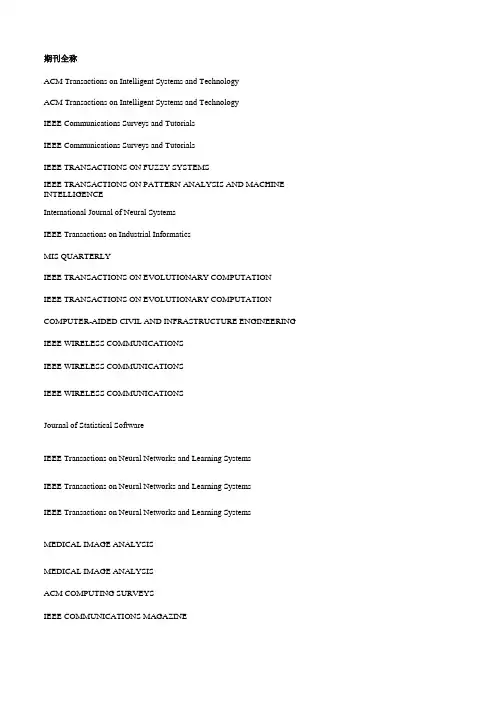
期刊全称ACM Transactions on Intelligent Systems and TechnologyACM Transactions on Intelligent Systems and TechnologyIEEE Communications Surveys and TutorialsIEEE Communications Surveys and TutorialsIEEE TRANSACTIONS ON FUZZY SYSTEMSIEEE TRANSACTIONS ON PATTERN ANALYSIS AND MACHINE INTELLIGENCE International Journal of Neural SystemsIEEE Transactions on Industrial InformaticsMIS QUARTERLYIEEE TRANSACTIONS ON EVOLUTIONARY COMPUTATIONIEEE TRANSACTIONS ON EVOLUTIONARY COMPUTATIONCOMPUTER-AIDED CIVIL AND INFRASTRUCTURE ENGINEERINGIEEE WIRELESS COMMUNICATIONSIEEE WIRELESS COMMUNICATIONSIEEE WIRELESS COMMUNICATIONSJournal of Statistical SoftwareIEEE Transactions on Neural Networks and Learning SystemsIEEE Transactions on Neural Networks and Learning SystemsIEEE Transactions on Neural Networks and Learning SystemsMEDICAL IMAGE ANALYSISMEDICAL IMAGE ANALYSISACM COMPUTING SURVEYSIEEE COMMUNICATIONS MAGAZINEINTEGRATED COMPUTER-AIDED ENGINEERINGINTEGRATED COMPUTER-AIDED ENGINEERINGENVIRONMENTAL MODELLING & SOFTWAREINTERNATIONAL JOURNAL OF COMPUTER VISIONIEEE Computational Intelligence MagazineIEEE JOURNAL ON SELECTED AREAS IN COMMUNICATIONSACM TRANSACTIONS ON GRAPHICSSIAM Journal on Imaging SciencesSIAM Journal on Imaging SciencesIEEE Transactions on Affective ComputingIEEE Transactions on Affective ComputingINFORMATION SCIENCESIEEE Transactions on CyberneticsIEEE Transactions on CyberneticsARCHIVES OF COMPUTATIONAL METHODS IN ENGINEERING JOURNAL OF INFORMATION TECHNOLOGYKNOWLEDGE-BASED SYSTEMSIEEE TRANSACTIONS ON IMAGE PROCESSINGJOURNAL OF MACHINE LEARNING RESEARCHIEEE NETWORKIEEE NETWORKIEEE NETWORKIEEE TRANSACTIONS ON INFORMATION THEORY JOURNAL OF LIGHTWAVE TECHNOLOGYCOMPUTERS & EDUCATIONKNOWLEDGE AND INFORMATION SYSTEMSKNOWLEDGE AND INFORMATION SYSTEMSIEEE TRANSACTIONS ON WIRELESS COMMUNICATIONS JOURNAL OF THE ACMJOURNAL OF THE ACMJOURNAL OF THE ACMJOURNAL OF THE ACMIEEE TRANSACTIONS ON MOBILE COMPUTINGIEEE TRANSACTIONS ON MOBILE COMPUTINGPATTERN RECOGNITIONAPPLIED SOFT COMPUTINGAPPLIED SOFT COMPUTINGCOMMUNICATIONS OF THE ACMCOMMUNICATIONS OF THE ACMCOMMUNICATIONS OF THE ACMInformation FusionInformation FusionARTIFICIAL INTELLIGENCEACM TRANSACTIONS ON MATHEMATICAL SOFTWAREIEEE TRANSACTIONS ON ANTENNAS AND PROPAGATION EVOLUTIONARY COMPUTATIONEVOLUTIONARY COMPUTATIONCOMPUTERS & CHEMICAL ENGINEERINGIEEE TRANSACTIONS ON SOFTWARE ENGINEERINGANNUAL REVIEW OF INFORMATION SCIENCE AND TECHNOLOGYIEEE TRANSACTIONS ON VEHICULAR TECHNOLOGYCHEMOMETRICS AND INTELLIGENT LABORATORY SYSTEMSIEEE Transactions on Systems Man Cybernetics-SystemsFUTURE GENERATION COMPUTER SYSTEMSIEEE TRANSACTIONS ON BROADCASTINGJOURNAL OF THE AMERICAN SOCIETY FOR INFORMATION SCIENCE AND TE NEURAL NETWORKSDATA MINING AND KNOWLEDGE DISCOVERYDATA MINING AND KNOWLEDGE DISCOVERYIEEE Transactions on Human-Machine SystemsIEEE Transactions on Human-Machine SystemsHUMAN-COMPUTER INTERACTIONHUMAN-COMPUTER INTERACTIONIEEE INTERNET COMPUTINGIEEE-ACM TRANSACTIONS ON NETWORKINGIEEE-ACM TRANSACTIONS ON NETWORKINGIEEE-ACM TRANSACTIONS ON NETWORKINGIEEE TRANSACTIONS ON VISUALIZATION AND COMPUTER GRAPHICS EXPERT SYSTEMS WITH APPLICATIONSIEEE INTELLIGENT SYSTEMSIEEE MICROIEEE MICRODECISION SUPPORT SYSTEMSDECISION SUPPORT SYSTEMSIEEE Transactions on Services ComputingIEEE Transactions on Services ComputingIEEE Transactions on Autonomous Mental DevelopmentARTIFICIAL LIFEARTIFICIAL LIFEIEEE Journal of Biomedical and Health InformaticsIEEE Journal of Biomedical and Health InformaticsIEEE PERVASIVE COMPUTINGIEEE PERVASIVE COMPUTINGINTERNATIONAL JOURNAL OF INFORMATION TECHNOLOGY & DECISION MA INTERNATIONAL JOURNAL OF INFORMATION TECHNOLOGY & DECISION MA INTERNATIONAL JOURNAL OF INFORMATION TECHNOLOGY & DECISION MA INFORMATION & MANAGEMENTINTERNATIONAL JOURNAL OF APPROXIMATE REASONINGBIOLOGICAL CYBERNETICSCOMPUTERS & STRUCTURESJOURNAL OF STRATEGIC INFORMATION SYSTEMSAd Hoc NetworksAd Hoc NetworksJOURNAL OF MATHEMATICAL IMAGING AND VISIONJOURNAL OF MATHEMATICAL IMAGING AND VISIONIEEE TRANSACTIONS ON MULTIMEDIAIEEE TRANSACTIONS ON MULTIMEDIAIEEE TRANSACTIONS ON MULTIMEDIAIEEE TRANSACTIONS ON COMMUNICATIONSIEEE TRANSACTIONS ON PARALLEL AND DISTRIBUTED SYSTEMSMobile Information SystemsMobile Information SystemsIEEE TRANSACTIONS ON KNOWLEDGE AND DATA ENGINEERINGIEEE TRANSACTIONS ON KNOWLEDGE AND DATA ENGINEERING COMPUTERS & OPERATIONS RESEARCHNEURAL COMPUTATIONIEEE Transactions on Information Forensics and SecurityIEEE MICROWAVE MAGAZINEIMAGE AND VISION COMPUTINGIMAGE AND VISION COMPUTINGIMAGE AND VISION COMPUTINGENGINEERING APPLICATIONS OF ARTIFICIAL INTELLIGENCEIEEE TRANSACTIONS ON RELIABILITYIEEE TRANSACTIONS ON RELIABILITYNEUROCOMPUTINGAUTONOMOUS ROBOTSADVANCED ENGINEERING INFORMATICSINTERNATIONAL JOURNAL OF ELECTRONIC COMMERCEInternational Journal of Web and Grid ServicesInternational Journal of Web and Grid ServicesCOMPUTERS AND ELECTRONICS IN AGRICULTUREIEEE Antennas and Wireless Propagation LettersUSER MODELING AND USER-ADAPTED INTERACTIONIEEE Transactions on HapticsSTRUCTURAL AND MULTIDISCIPLINARY OPTIMIZATIONCOMPUTER GRAPHICS FORUMJournal of Optical Communications and NetworkingJournal of Optical Communications and NetworkingJournal of Optical Communications and NetworkingCOMPUTERS & INDUSTRIAL ENGINEERINGMACHINE LEARNINGACM Transactions on Sensor NetworksACM Transactions on Sensor NetworksEUROPEAN JOURNAL OF INFORMATION SYSTEMSJournal of Computational ScienceJournal of Computational ScienceCOMPUTERS IN INDUSTRYIEEE-ACM Transactions on Computational Biology and BioinformaticsEMPIRICAL SOFTWARE ENGINEERINGVLDB JOURNALVLDB JOURNALJOURNAL OF MANAGEMENT INFORMATION SYSTEMSCOMPUTER SPEECH AND LANGUAGECOMPUTERCOMPUTERJournal of Grid ComputingJournal of Grid ComputingInternational Journal of Bio-Inspired ComputationInternational Journal of Bio-Inspired ComputationPervasive and Mobile ComputingPervasive and Mobile ComputingINDUSTRIAL MANAGEMENT & DATA SYSTEMSINTERNATIONAL JOURNAL OF INTELLIGENT SYSTEMSIEEE Transactions on Computational Intelligence and AI in GamesIEEE Transactions on Computational Intelligence and AI in GamesDATA & KNOWLEDGE ENGINEERINGDATA & KNOWLEDGE ENGINEERINGPARALLEL COMPUTINGCOMPUTING IN SCIENCE & ENGINEERINGMECHATRONICSCOMPUTER METHODS IN BIOMECHANICS AND BIOMEDICAL ENGINEERING IEEE SOFTWARESOFT COMPUTINGSOFT COMPUTINGJOURNAL OF NETWORK AND COMPUTER APPLICATIONSJOURNAL OF NETWORK AND COMPUTER APPLICATIONSJOURNAL OF NETWORK AND COMPUTER APPLICATIONSACM TRANSACTIONS ON SOFTWARE ENGINEERING AND METHODOLOGY TELECOMMUNICATIONS POLICYElectronic Commerce Research and ApplicationsElectronic Commerce Research and ApplicationsINTERNET RESEARCH-ELECTRONIC NETWORKING APPLICATIONS AND POLI INTERNET RESEARCH-ELECTRONIC NETWORKING APPLICATIONS AND POLIACM Transactions on Knowledge Discovery from DataACM Transactions on Knowledge Discovery from DataROBOTICS AND COMPUTER-INTEGRATED MANUFACTURING INFORMATION SYSTEMSWiley Interdisciplinary Reviews-Data Mining and Knowledge DiscoveryWiley Interdisciplinary Reviews-Data Mining and Knowledge DiscoveryCOMPUTER METHODS AND PROGRAMS IN BIOMEDICINECOMPUTER METHODS AND PROGRAMS IN BIOMEDICINEINFORMATION AND SOFTWARE TECHNOLOGYINFORMATION AND SOFTWARE TECHNOLOGYSPEECH COMMUNICATIONJOURNAL OF HEURISTICSJOURNAL OF HEURISTICSARTIFICIAL INTELLIGENCE IN MEDICINECOMPUTER-AIDED DESIGNJOURNAL OF COMPUTING IN CIVIL ENGINEERINGFuzzy Optimization and Decision MakingJournal of the Association for Information SystemsIEEE TRANSACTIONS ON COMPUTERSIEEE Systems JournalIEEE Systems JournalCOMPUTER VISION AND IMAGE UNDERSTANDINGOPTICAL FIBER TECHNOLOGYJournal of Web SemanticsJournal of Web SemanticsJournal of Web SemanticsIEEE Vehicular Technology MagazineINTERNATIONAL JOURNAL OF SYSTEMS SCIENCEACM Transactions on the WebACM Transactions on the WebIEEE TRANSACTIONS ON ELECTROMAGNETIC COMPATIBILITYIEEE TRANSACTIONS ON AEROSPACE AND ELECTRONIC SYSTEMSIEEE COMPUTER GRAPHICS AND APPLICATIONSINTERNATIONAL JOURNAL OF HUMAN-COMPUTER STUDIESADVANCES IN ENGINEERING SOFTWAREADVANCES IN ENGINEERING SOFTWARECOMPUTERS IN BIOLOGY AND MEDICINECOMPUTER NETWORKS-THE INTERNATIONAL JOURNAL OF COMPUTER AND COMPUTER NETWORKS-THE INTERNATIONAL JOURNAL OF COMPUTER AND COMPUTER NETWORKS-THE INTERNATIONAL JOURNAL OF COMPUTER AND Swarm IntelligenceInternational Journal of Fuzzy SystemsPersonal and Ubiquitous ComputingPersonal and Ubiquitous ComputingJOURNAL OF VISUAL COMMUNICATION AND IMAGE REPRESENTATION JOURNAL OF VISUAL COMMUNICATION AND IMAGE REPRESENTATION ARTIFICIAL INTELLIGENCE REVIEWINFORMATICANEURAL COMPUTING & APPLICATIONSJOURNAL OF INFORMATION SCIENCECOMPUTATIONAL LINGUISTICSCOMPUTATIONAL LINGUISTICSIEEE COMMUNICATIONS LETTERSIEEE TRANSACTIONS ON VERY LARGE SCALE INTEGRATION (VLSI) SYSTEM IEEE TRANSACTIONS ON COMPUTER-AIDED DESIGN OF INTEGRATED CIRCU IEEE TRANSACTIONS ON COMPUTER-AIDED DESIGN OF INTEGRATED CIRCU INFORMS JOURNAL ON COMPUTINGINTERNATIONAL JOURNAL OF HIGH PERFORMANCE COMPUTING APPLICAT INTERNATIONAL JOURNAL OF HIGH PERFORMANCE COMPUTING APPLICAT INTERNATIONAL JOURNAL OF HIGH PERFORMANCE COMPUTING APPLICAT MACHINE VISION AND APPLICATIONSMACHINE VISION AND APPLICATIONSJOURNAL OF HYDROINFORMATICSRADIO SCIENCEJOURNAL OF COMPLEXITYAutomated Software EngineeringENGINEERING COMPUTATIONSCOMPUTER COMMUNICATIONSCOMPUTER COMMUNICATIONSACM TRANSACTIONS ON INFORMATION SYSTEMSMOBILE NETWORKS & APPLICATIONSMOBILE NETWORKS & APPLICATIONSMOBILE NETWORKS & APPLICATIONSIEEE Design & TestCOMPUTER STANDARDS & INTERFACESCOMPUTER STANDARDS & INTERFACESGenetic Programming and Evolvable MachinesGenetic Programming and Evolvable MachinesMULTIDIMENSIONAL SYSTEMS AND SIGNAL PROCESSINGPATTERN RECOGNITION LETTERSIEEE Transactions on Dependable and Secure ComputingIEEE Transactions on Dependable and Secure ComputingIEEE Transactions on Dependable and Secure ComputingWORLD WIDE WEB-INTERNET AND WEB INFORMATION SYSTEMSWORLD WIDE WEB-INTERNET AND WEB INFORMATION SYSTEMSONLINE INFORMATION REVIEWROBOTICS AND AUTONOMOUS SYSTEMSJournal of Real-Time Image ProcessingINTERNATIONAL JOURNAL OF UNCERTAINTY FUZZINESS AND KNOWLEDGE ADAPTIVE BEHAVIORJOURNAL OF INTELLIGENT MANUFACTURINGJOURNAL OF COMPUTER AND SYSTEM SCIENCESJOURNAL OF COMPUTER AND SYSTEM SCIENCESNEURAL PROCESSING LETTERSJOURNAL OF SYSTEMS AND SOFTWAREJOURNAL OF SYSTEMS AND SOFTWARESOFTWARE TESTING VERIFICATION & RELIABILITYCOMPUTERS & SECURITYACM Transactions on Applied PerceptionIEEE MULTIMEDIAIEEE MULTIMEDIAIEEE MULTIMEDIAIEEE MULTIMEDIAIEEE TRANSACTIONS ON CONSUMER ELECTRONICSSIMULATION MODELLING PRACTICE AND THEORYSIMULATION MODELLING PRACTICE AND THEORYREQUIREMENTS ENGINEERINGREQUIREMENTS ENGINEERINGComputer Supported Cooperative Work-The Journal of Collaborative Computing DISPLAYSSoftware and Systems ModelingINTERACTING WITH COMPUTERSAUTONOMOUS AGENTS AND MULTI-AGENT SYSTEMSBusiness & Information Systems EngineeringJOURNAL OF ARTIFICIAL INTELLIGENCE RESEARCHINTERNATIONAL JOURNAL OF SATELLITE COMMUNICATIONS AND NETWOR ACM Transactions on Autonomous and Adaptive SystemsACM Transactions on Autonomous and Adaptive SystemsACM Transactions on Autonomous and Adaptive SystemsWIRELESS COMMUNICATIONS & MOBILE COMPUTINGWIRELESS COMMUNICATIONS & MOBILE COMPUTINGINTERNATIONAL JOURNAL OF COMPUTER INTEGRATED MANUFACTURING JOURNAL OF PARALLEL AND DISTRIBUTED COMPUTINGApplied OntologyApplied OntologyApplied OntologyJournal of Ambient Intelligence and Smart EnvironmentsJournal of Ambient Intelligence and Smart EnvironmentsJournal of Ambient Intelligence and Smart EnvironmentsINFORMATION PROCESSING & MANAGEMENTInternational Journal on Semantic Web and Information SystemsInternational Journal on Semantic Web and Information SystemsInternational Journal of Applied Mathematics and Computer Science TELECOMMUNICATION SYSTEMSOPEN SYSTEMS & INFORMATION DYNAMICSJOURNAL OF CRYPTOLOGYSIAM JOURNAL ON COMPUTINGJournal of Software-Evolution and ProcessIET OptoelectronicsCOMPUTATIONAL INTELLIGENCEIET Radar Sonar and NavigationCOMPUTERS & GRAPHICS-UKINTERNATIONAL JOURNAL OF HUMAN-COMPUTER INTERACTIONIEEE Transactions on Learning TechnologiesAPPLIED COMPUTATIONAL ELECTROMAGNETICS SOCIETY JOURNALACM TRANSACTIONS ON PROGRAMMING LANGUAGES AND SYSTEMS COMPUTER AIDED GEOMETRIC DESIGNCOMPUTERS & ELECTRICAL ENGINEERINGCOMPUTERS & ELECTRICAL ENGINEERINGJOURNAL OF DATABASE MANAGEMENTJOURNAL OF DATABASE MANAGEMENTBEHAVIOUR & INFORMATION TECHNOLOGYACM Transactions on Multimedia Computing Communications and ApplicationsACM Transactions on Multimedia Computing Communications and ApplicationsACM Transactions on Multimedia Computing Communications and Applications MULTIMEDIA TOOLS AND APPLICATIONSMULTIMEDIA TOOLS AND APPLICATIONSMULTIMEDIA TOOLS AND APPLICATIONSIEEE Computer Architecture LettersCognitive Systems ResearchSOFTWARE-PRACTICE & EXPERIENCEScientific ProgrammingGRAPHICAL MODELSCYBERNETICS AND SYSTEMSACM SIGCOMM Computer Communication ReviewInformation VisualizationPRESENCE-TELEOPERATORS AND VIRTUAL ENVIRONMENTSPRESENCE-TELEOPERATORS AND VIRTUAL ENVIRONMENTSACM TRANSACTIONS ON DATABASE SYSTEMSACM TRANSACTIONS ON DATABASE SYSTEMSOptical Switching and NetworkingOptical Switching and NetworkingJOURNAL OF FUNCTIONAL PROGRAMMINGACM TRANSACTIONS ON COMPUTER SYSTEMSACM Transactions on Computer-Human InteractionACM Transactions on Computer-Human InteractionComputers and ConcreteETRI JOURNALIEEE SECURITY & PRIVACYIEEE SECURITY & PRIVACYR JournalCOMPUTINGVISUAL COMPUTERACM Transactions on StorageACM Transactions on StorageCONSTRAINTSCONSTRAINTSOPTIMIZATION METHODS & SOFTWAREINFORMATION SYSTEMS FRONTIERSINFORMATION SYSTEMS FRONTIERSEUROPEAN TRANSACTIONS ON TELECOMMUNICATIONS PERFORMANCE EVALUATIONPERFORMANCE EVALUATIONIET Microwaves Antennas & PropagationACM Transactions on Modeling and Computer SimulationJOURNAL OF INTELLIGENT & ROBOTIC SYSTEMSACM Transactions on Embedded Computing SystemsACM Transactions on Embedded Computing SystemsCIN-COMPUTERS INFORMATICS NURSINGCOMPUTER JOURNALCOMPUTER JOURNALCOMPUTER JOURNALCOMPUTER JOURNALENGINEERING WITH COMPUTERSDESIGNS CODES AND CRYPTOGRAPHYNETWORKSNETWORK-COMPUTATION IN NEURAL SYSTEMSInformation Technology and ControlInformation Technology and ControlIETE TECHNICAL REVIEWInternational Journal of Data Warehousing and MiningJOURNAL OF SUPERCOMPUTINGJOURNAL OF SUPERCOMPUTINGNEW GENERATION COMPUTINGNEW GENERATION COMPUTINGWIRELESS NETWORKSWIRELESS NETWORKSPATTERN ANALYSIS AND APPLICATIONSJOURNAL OF INTELLIGENT & FUZZY SYSTEMS CONCURRENCY AND COMPUTATION-PRACTICE & EXPERIENCE CONCURRENCY AND COMPUTATION-PRACTICE & EXPERIENCE ACM Transactions on Internet TechnologyACM Transactions on Internet TechnologyInternational Journal of Ad Hoc and Ubiquitous ComputingInternational Journal of Ad Hoc and Ubiquitous ComputingACM Transactions on Computational LogicACM Transactions on Information and System SecurityCluster Computing-The Journal of Networks Software Tools and ApplicationsCluster Computing-The Journal of Networks Software Tools and Applications INTERNATIONAL JOURNAL OF COMMUNICATION SYSTEMSEURASIP Journal on Wireless Communications and NetworkingEXPERT SYSTEMSEXPERT SYSTEMSINTERNATIONAL JOURNAL OF RF AND MICROWAVE COMPUTER-AIDED ENG INTERNATIONAL JOURNAL OF GENERAL SYSTEMSINFORMATION RETRIEVALMODELING IDENTIFICATION AND CONTROLCONNECTION SCIENCECONNECTION SCIENCESOFTWARE QUALITY JOURNALSIMULATION-TRANSACTIONS OF THE SOCIETY FOR MODELING AND SIMULA SIMULATION-TRANSACTIONS OF THE SOCIETY FOR MODELING AND SIMULA Digital InvestigationDigital InvestigationDISTRIBUTED AND PARALLEL DATABASESDISTRIBUTED AND PARALLEL DATABASESKNOWLEDGE ENGINEERING REVIEWSIGMOD RECORDSIGMOD RECORDJOURNAL OF INTELLIGENT INFORMATION SYSTEMSJOURNAL OF INTELLIGENT INFORMATION SYSTEMSInternational Journal of Wavelets Multiresolution and Information Processing International Journal on Document Analysis and RecognitionJOURNAL OF COMPUTER INFORMATION SYSTEMSINTERNATIONAL JOURNAL OF COOPERATIVE INFORMATION SYSTEMSAI MAGAZINEIET Computer VisionACM Journal on Emerging Technologies in Computing SystemsDISTRIBUTED COMPUTINGInternational Journal of Antennas and PropagationJOURNAL OF MULTIPLE-VALUED LOGIC AND SOFT COMPUTINGJOURNAL OF MULTIPLE-VALUED LOGIC AND SOFT COMPUTINGBELL LABS TECHNICAL JOURNALBELL LABS TECHNICAL JOURNALJournal on Multimodal User InterfacesJournal on Multimodal User InterfacesCryptography and Communications-Discrete-Structures Boolean Functions and Sequences Science China-Information SciencesAPPLICABLE ALGEBRA IN ENGINEERING COMMUNICATION AND COMPUTIN APPLICABLE ALGEBRA IN ENGINEERING COMMUNICATION AND COMPUTIN IBM JOURNAL OF RESEARCH AND DEVELOPMENTIBM JOURNAL OF RESEARCH AND DEVELOPMENTIBM JOURNAL OF RESEARCH AND DEVELOPMENTIBM JOURNAL OF RESEARCH AND DEVELOPMENTREAL-TIME SYSTEMSCOMPUTER MUSIC JOURNALWIRELESS PERSONAL COMMUNICATIONSINFORMATION AND COMPUTATIONJOURNAL OF SYSTEMS ARCHITECTUREJOURNAL OF SYSTEMS ARCHITECTUREACM TRANSACTIONS ON DESIGN AUTOMATION OF ELECTRONIC SYSTEMS ACM TRANSACTIONS ON DESIGN AUTOMATION OF ELECTRONIC SYSTEMS International Journal of Distributed Sensor NetworksInternational Journal of Distributed Sensor NetworksTHEORY AND PRACTICE OF LOGIC PROGRAMMINGTHEORY AND PRACTICE OF LOGIC PROGRAMMINGACM Transactions on Architecture and Code OptimizationACM Transactions on Architecture and Code OptimizationInternational Journal of Information SecurityInternational Journal of Information SecurityInternational Journal of Information SecurityAEU-INTERNATIONAL JOURNAL OF ELECTRONICS AND COMMUNICATIONS Natural ComputingNatural ComputingJOURNAL OF SYMBOLIC COMPUTATIONJournal of Signal Processing Systems for Signal Image and Video Technology MULTIMEDIA SYSTEMSMULTIMEDIA SYSTEMSMATHEMATICAL STRUCTURES IN COMPUTER SCIENCEJOURNAL OF LOGIC AND COMPUTATIONINFORMATION SYSTEMS MANAGEMENTAdvances in Electrical and Computer EngineeringComputer Science and Information SystemsComputer Science and Information SystemsJOURNAL OF AUTOMATED REASONINGAI EDAM-ARTIFICIAL INTELLIGENCE FOR ENGINEERING DESIGN ANALYSIS AI EDAM-ARTIFICIAL INTELLIGENCE FOR ENGINEERING DESIGN ANALYSIS INTERNATIONAL JOURNAL OF PATTERN RECOGNITION AND ARTIFICIAL INT SCIENCE OF COMPUTER PROGRAMMINGComputational and Mathematical Organization TheoryMICROPROCESSORS AND MICROSYSTEMSMICROPROCESSORS AND MICROSYSTEMSAdvances in Mathematics of CommunicationsJOURNAL OF VISUAL LANGUAGES AND COMPUTINGJournal of SimulationJOURNAL OF COMPUTER SCIENCE AND TECHNOLOGYJOURNAL OF COMPUTER SCIENCE AND TECHNOLOGYPHOTONIC NETWORK COMMUNICATIONSPHOTONIC NETWORK COMMUNICATIONSDISCRETE MATHEMATICS AND THEORETICAL COMPUTER SCIENCE THEORETICAL COMPUTER SCIENCEALGORITHMICAASLIB PROCEEDINGSKYBERNETIKAANNALES DES TELECOMMUNICATIONS-ANNALS OF TELECOMMUNICATION INTEGRATION-THE VLSI JOURNALInternational Journal of Critical Infrastructure ProtectionACM Transactions on AlgorithmsInternational Journal of Computers Communications & ControlFORMAL ASPECTS OF COMPUTINGJOURNAL OF UNIVERSAL COMPUTER SCIENCEJOURNAL OF UNIVERSAL COMPUTER SCIENCECONCURRENT ENGINEERING-RESEARCH AND APPLICATIONSANALOG INTEGRATED CIRCUITS AND SIGNAL PROCESSINGInternational Journal of Microwave and Wireless TechnologiesJOURNAL OF COMPUTING AND INFORMATION SCIENCE IN ENGINEERING JOURNAL OF VISUALIZATIONIET SoftwareInternational Journal of Unconventional ComputingTurkish Journal of Electrical Engineering and Computer SciencesLanguage Resources and EvaluationIEEE ANNALS OF THE HISTORY OF COMPUTINGINTERNATIONAL JOURNAL OF PARALLEL PROGRAMMINGIT ProfessionalIT ProfessionalIT ProfessionalJOURNAL OF NEW MUSIC RESEARCHINFORMATION PROCESSING LETTERSIntelligent Data AnalysisNeural Network WorldJOURNAL OF LOGIC AND ALGEBRAIC PROGRAMMINGACM SIGPLAN NOTICESAI COMMUNICATIONSJournal of Internet TechnologyJournal of Internet TechnologyIET Information SecurityIET Information SecurityJournal of Applied LogicJournal of Applied LogicFORMAL METHODS IN SYSTEM DESIGNTHEORY OF COMPUTING SYSTEMSNatural Language EngineeringVIRTUAL REALITYVIRTUAL REALITYInternational Journal of Computational Intelligence SystemsInternational Journal of Computational Intelligence SystemsJOURNAL OF COMMUNICATIONS AND NETWORKSJOURNAL OF COMMUNICATIONS AND NETWORKSMINDS AND MACHINESACTA INFORMATICAJournal of Network and Systems ManagementJournal of Network and Systems ManagementAd Hoc & Sensor Wireless NetworksAd Hoc & Sensor Wireless NetworksKSII Transactions on Internet and Information SystemsKSII Transactions on Internet and Information SystemsLogical Methods in Computer ScienceUniversal Access in the Information SocietyCOMPUTER ANIMATION AND VIRTUAL WORLDSInternational Journal of Network ManagementInternational Journal of Network ManagementJOURNAL OF ORGANIZATIONAL COMPUTING AND ELECTRONIC COMMERCE JOURNAL OF ORGANIZATIONAL COMPUTING AND ELECTRONIC COMMERCE FUNDAMENTA INFORMATICAEADVANCES IN COMPUTERSADVANCES IN COMPUTERSAPPLIED ARTIFICIAL INTELLIGENCEJOURNAL OF EXPERIMENTAL & THEORETICAL ARTIFICIAL INTELLIGENCE PROGRAM-ELECTRONIC LIBRARY AND INFORMATION SYSTEMSSecurity and Communication NetworksSecurity and Communication NetworksProblems of Information TransmissionNew Review of Hypermedia and MultimediaINTERNATIONAL JOURNAL OF FOUNDATIONS OF COMPUTER SCIENCE COMPUTER APPLICATIONS IN ENGINEERING EDUCATIONIET Computers and Digital TechniquesIET Computers and Digital TechniquesJOURNAL OF COMMUNICATIONS TECHNOLOGY AND ELECTRONICS Frontiers of Computer ScienceFrontiers of Computer ScienceFrontiers of Computer SciencePeer-to-Peer Networking and ApplicationsPeer-to-Peer Networking and ApplicationsANNALS OF MATHEMATICS AND ARTIFICIAL INTELLIGENCEChina CommunicationsCOMPUTER LANGUAGES SYSTEMS & STRUCTURESCOMPEL-THE INTERNATIONAL JOURNAL FOR COMPUTATION AND MATHEM International Journal of Web Services ResearchInternational Journal of Web Services ResearchJournal of Organizational and End User ComputingJournal of Zhejiang University-SCIENCE C-Computers & ElectronicsJournal of Zhejiang University-SCIENCE C-Computers & ElectronicsKYBERNETESJournal of Cellular AutomataIEICE TRANSACTIONS ON COMMUNICATIONSRomanian Journal of Information Science and TechnologyInternational Arab Journal of InformationInternational Arab Journal of InformationCANADIAN JOURNAL OF ELECTRICAL AND COMPUTER ENGINEERING-REVU JOURNAL OF CIRCUITS SYSTEMS AND COMPUTERSMalaysian Journal of Computer ScienceMalaysian Journal of Computer ScienceCOMPUTING AND INFORMATICSJOURNAL OF INFORMATION SCIENCE AND ENGINEERINGJournal of Web EngineeringJournal of Web EngineeringInternational Journal on Artificial Intelligence ToolsInternational Journal on Artificial Intelligence ToolsRAIRO-THEORETICAL INFORMATICS AND APPLICATIONSIEEE Latin America TransactionsDESIGN AUTOMATION FOR EMBEDDED SYSTEMSDESIGN AUTOMATION FOR EMBEDDED SYSTEMSIEICE TRANSACTIONS ON FUNDAMENTALS OF ELECTRONICS COMMUNICAT IEICE TRANSACTIONS ON FUNDAMENTALS OF ELECTRONICS COMMUNICAT INTERNATIONAL JOURNAL OF SOFTWARE ENGINEERING AND KNOWLEDGE INTERNATIONAL JOURNAL OF SOFTWARE ENGINEERING AND KNOWLEDGE COMPUTER SYSTEMS SCIENCE AND ENGINEERINGCOMPUTER SYSTEMS SCIENCE AND ENGINEERINGJOURNAL OF COMPUTER AND SYSTEMS SCIENCES INTERNATIONAL JOURNAL OF COMPUTER AND SYSTEMS SCIENCES INTERNATIONAL JOURNAL OF COMPUTER AND SYSTEMS SCIENCES INTERNATIONALIETE JOURNAL OF RESEARCHMICROWAVE JOURNALIEICE TRANSACTIONS ON INFORMATION AND SYSTEMSIEICE TRANSACTIONS ON INFORMATION AND SYSTEMSCRYPTOLOGIAINTELLIGENT AUTOMATION AND SOFT COMPUTINGPROGRAMMING AND COMPUTER SOFTWARETraitement du SignalJournal of the Institute of Telecommunications ProfessionalsMICROWAVES & RFELECTRONICS WORLDCOMPUTER GRAPHICS WORLDJCR期刊简称ISSN所属小类所属小类(中文)小类分区大类复分大类分区ACM T INTEL SYST TEC2157-6904C OMPUTER SCIENCE, ARTI计算机:人工智能1N1 ACM T INTEL SYST TEC2157-6904C OMPUTER SCIENCE, INFO计算机:信息系统1N1 IEEE COMMUN SURV TUT1553-877X T ELECOMMUNICATIONS电信学1N1 IEEE COMMUN SURV TUT1553-877X C OMPUTER SCIENCE, INFO计算机:信息系统1N1 IEEE T FUZZY SYST1063-6706C OMPUTER SCIENCE, ARTI计算机:人工智能1N1 IEEE T PATTERN ANAL0162-8828C OMPUTER SCIENCE, ARTI计算机:人工智能1N1 INT J NEURAL SYST0129-0657C OMPUTER SCIENCE, ARTI计算机:人工智能1N1 IEEE T IND INFORM1551-3203C OMPUTER SCIENCE, INTE计算机:跨学科应1N1 MIS QUART0276-7783C OMPUTER SCIENCE, INFO计算机:信息系统1N1 IEEE T EVOLUT COMPUT1089-778X C OMPUTER SCIENCE, THEO计算机:理论方法1N1 IEEE T EVOLUT COMPUT1089-778X C OMPUTER SCIENCE, ARTI计算机:人工智能1N1 COMPUT-AIDED CIV INF1093-9687C OMPUTER SCIENCE, INTE计算机:跨学科应1N1 IEEE WIREL COMMUN1536-1284T ELECOMMUNICATIONS电信学1N1 IEEE WIREL COMMUN1536-1284C OMPUTER SCIENCE, INFO计算机:信息系统1N1 IEEE WIREL COMMUN1536-1284C OMPUTER SCIENCE, HAR计算机:硬件1N1 J STAT SOFTW1548-7660C OMPUTER SCIENCE, INTE计算机:跨学科应1N1 IEEE T NEUR NET LEAR2162-237X C OMPUTER SCIENCE, THEO计算机:理论方法1N1 IEEE T NEUR NET LEAR2162-237X C OMPUTER SCIENCE, ARTI计算机:人工智能1N1 IEEE T NEUR NET LEAR2162-237X C OMPUTER SCIENCE, HAR计算机:硬件1N1 MED IMAGE ANAL1361-8415C OMPUTER SCIENCE, INTE计算机:跨学科应1N1 MED IMAGE ANAL1361-8415C OMPUTER SCIENCE, ARTI计算机:人工智能2N1 ACM COMPUT SURV0360-0300C OMPUTER SCIENCE, THEO计算机:理论方法1N1 IEEE COMMUN MAG0163-6804T ELECOMMUNICATIONS电信学1N2 INTEGR COMPUT-AID E1069-2509C OMPUTER SCIENCE, INTE计算机:跨学科应2N2 INTEGR COMPUT-AID E1069-2509C OMPUTER SCIENCE, ARTI计算机:人工智能2N2 ENVIRON MODELL SOFTW1364-8152C OMPUTER SCIENCE, INTE计算机:跨学科应2N2 INT J COMPUT VISION0920-5691C OMPUTER SCIENCE, ARTI计算机:人工智能2N2 IEEE COMPUT INTELL M1556-603X C OMPUTER SCIENCE, ARTI计算机:人工智能2N2 IEEE J SEL AREA COMM0733-8716T ELECOMMUNICATIONS电信学1N2 ACM T GRAPHIC0730-0301C OMPUTER SCIENCE, SOFT计算机:软件工程1N2 SIAM J IMAGING SCI1936-4954C OMPUTER SCIENCE, ARTI计算机:人工智能2N2 SIAM J IMAGING SCI1936-4954C OMPUTER SCIENCE, SOFT计算机:软件工程1N2 IEEE T AFFECT COMPUT1949-3045C OMPUTER SCIENCE, CYB计算机:控制论1N2。


大数据融合研究:问题与挑战孟小峰;杜治娟【摘要】随着大规模数据的关联和交叉,数据特征和现实需求都发生了变化.以大规模、多源异构、跨领域、跨媒体、跨语言、动态演化、普适化为主要特征的数据发挥着更重要的作用,相应的数据存储、分析和理解也面临着重大挑战.当下亟待解决的问题是如何利用数据的关联、交叉和融合实现大数据的价值最大化.认为解决这一问题的关键在于数据的融合,所以提出了大数据融合的概念.首先以Web数据、科学数据和商业数据的融合作为案例分析了大数据融合的需求和必要性,并提出了大数据融合的新任务;然后,总结分析了现有融合技术;最后针对大数据融合问题可能面临的挑战和大数据融合带来的问题进行了分析.【期刊名称】《计算机研究与发展》【年(卷),期】2016(053)002【总页数】18页(P229-246)【关键词】大数据;数据集成;数据融合;知识融合;数据管理【作者】孟小峰;杜治娟【作者单位】中国人民大学信息学院北京 100872;中国人民大学信息学院北京100872【正文语种】中文【中图分类】TP391近20年里,数据产生的方式不断在扩展,数据之间的关系变得千丝万缕,呈现出大规模数据关联、交叉和融合的局面[1-2],数据出现了如下新的特征:1)多元性.当下数据不仅是类型多样,更重要的是数据内容的“维度”多样和知识范畴的“粒度”多样,呈现出一种多元性.它体现了数据与知识之间的立体关系,而非单纯数据类型多样,与演化性成为当下大数据的精髓,是区别于大规模数据、海量数据、或早期“大数据”(量大)的最显著特征.2)演化性.是指数据随时间或解释的变化而变化的特性,体现了数据的动态性和知识的演化性.比如,实体的某些属性在不同时间点可能产生变化.这就要求合理建模演化行为,保证数据一致性.它与高速性共同构成了知识的动态演化性,更加贴切地体现出现实数据的本原性,而非单纯地强调速度.3)真实性.主要由实体的同名异义表示和异名同义表示以及关系的变化引起.这种现象普遍存在,它们增加了理解的不确定性.真实性由演化性引起,反过来又为演化性提供了印证,只有知识得到印证才能使演化更新和融合更有意义.4)普适性.是指在认知范围内可以达成共识关系的特征,比如,“老师”和“蜡烛”在神经元连接上具有普适性.这种普适性发现源于知识之间隐性关联的发现,它也比信息本身的增长更有价值.这是将大数据定位到知识层面的一个独特特征.这导致大数据集成的对象已经不单是数据,而是数据和知识的复合体,可以称之为“数据湖”(data lake),其内涵到底是什么呢?偶读了68年前费孝通《乡土中国》[3],略有所悟.费老分析总结了中国乡土社会结构,指出中国社会呈现出所谓的“差序格局”,而西方社会呈现的是“团体格局”.传统数据库结构关系单一,呈现状态犹如“团体格局”,即以单个实体为本位,实体之间的关系好比一捆柴,几根成一把,几把成一扎,条理清楚,有共同的模式可循.而当下大数据来源广泛,关系复杂,远近亲疏各不同,这种关系就好比“差序格局”,以语义主题为本位,每类实体都以自我为中心按照与其他实体的语义关系为主线结成网络,这个网络按照关系的语义紧密亲疏呈现“差序”状态,就如同湖面丢下的石子形成的水波纹依中心扩散开去.这种状态随着实体间关系的变化而动态演化,并且每个网络的大小不同,体现的语义关系也不同,蕴含的价值也不同.数据库的“团体格局”本质上是先有模式后有数据,因此数据集成可以采用中介模式的方法(全局视图(global-as-view,GAV),局部视图(local-as-view,LAV))以自顶向下的方式实现集成.数据湖的“差序格局”是先有数据后有模式,因此需要一种自底向上的方式以一种大数据融合的方法实现集成.大数据融合即建立数据间、信息间、知识片段间多维度、多粒度的关联关系,实现更多层面的知识交互,从而聚敛出数据湖中一个个维系我们社会的“水波纹”(即语义关联的紧密程度).本文首先分析了大数据融合的现实需求并提出大数据融合的问题,探讨了现有融合技术的发展现状,并给出大数据融合的理解,指出了大数据融合面临的挑战.大数据融合是最大程度发挥大数据价值的一种手段,它的实现可以使人类对世界的探索和认识向新的深度和广度拓展.它不同于传统的数据集成或知识库技术,需要大跨度、深层次和综合性的研究方法.下面我们通过几个不同领域的案例分析来具体探讨这一问题的本质.1.1 公共安全领域大数据融合案例分析公共安全领域的数据包括结构化数据和非结构数据.其中结构化数据包括人员信息(比如人员户籍库、重点人员库等)、人员行为轨迹数据(比如飞机、火车出行数据等)、车辆信息(比如车辆购买信息、违章信息等)、电信数据(比如话单)等;非结构化数据包括网页、卡口图片、重点区域的视频监控录像等.公共安全领域数据的主要应用场景是公安办案提供线索.这种数据比较复杂,规模也较大,如中国某省会城市一小部分数据构建成图,其顶点的个数和边的个数分别达到了十亿和百亿的规模.1.1.1 实现原理目前采取的方案是基于超大规模复杂关联数据的管理理论建立超大规模的实体关联图.图上的每个顶点代表自然界的一个客观对象,比如人员、物品、住所等;图上的边表示实体之间的关系.如图1所示.这种方案总体上可以分为4步实现:1)数据治理.需要把物理上相互隔离的多源异构数据通过数据治理整合到统一的数据平台,该过程是后面3步的前提和基础.目前在实际的工程实践中采用以人工为主的操作模式.2)关系构建.这个过程需要自动地构建实体之间的显式关系和隐式关系,并存储在图数据库.隐式关系的构建借助规则或机器学习.3)可视化交互分析.系统提供强大的可视化交互分析工具,帮助用户在超大规模图上做各种分析和关系推演和比对.4)基于以上3步构建各警种的具体应用.1.1.2 现实需求当下,在工程实际中公共安全领域数据融合系统还需要很大改观.1)所需的数据割裂地分布在多个数据源中,且数据种类多样,需要把这些割裂的多源数据自动整合为一个统一的系统.2)目前公共安全领域的系统绝大多数提供的服务属于事后研判型,但是有些重大案件的破坏性非常大,事后再研判损失太大,急需能够做到事前预警的大数据技术和系统.3)嫌犯可能会在作案后更改姓名、手机号码、常驻地等,这样会造成数据的演化,需要识别这种演化,这对于破案极为重要.4)所需数据规模超大,比如为了找到涉恐人员的蛛丝马迹,需要对整个互联网和电信网路进行监控和分析处理,这里需要处理的数据目前工业界无法承受,需要控制融合的规模.1.2 科学大数据融合案例分析在科研领域,不仅需要数据本身,更需要与该数据有潜在密切关系的各种数据,并能够方便地分析这些数据.例如,在查看一个基因数据时,还能循着它去看基因组、蛋白质等相关的其他数据.为了实现这种融合,中国科学院提出了数据融合管理与服务系统,目前包括36个不同数据源的生物学数据,累计汇聚数据超过40TB;并在此基础上选取了8个数据源的数据进行数据解析、转换和数据关联处理,转换得到的约830万个数据之间建立起了约1.4亿个关联关系.1.2.1 实现原理该系统的实现原理如图2所示.图2中,集中的数据存储库基于分布式文件系统MooseFS、MongoDB数据库集群和Virtuoso数据库来构建,分别用于存储从各数据源下载的非结构化数据、从各数据源下载的结构化数据和解析原始数据后得到的数据、转换得到的RDF数据和通过语义增强系统新建立的关联关系数据.这些数据通过数据汇聚模块的各种下载组件和管理系统进行汇聚.对于下载的数据,定制化开发数据解析工具,完成数据从原始形态到“属性值”结构化形态的转变;开发基于配置的数据转换工具,抽取对发现数据之间的关联有价值的“属性值”并经必要的数据合并、拆分、等价变换等处理将抽取的这些数据转变为一致化的RDF格式;确定数据之间的关联机制并在此基础上运用相似度计算、推理、本体映射等关联发现方法来增加数据之间的语义关联关系.最后通过服务接口模块对外提供服务.1.2.2 现实需求从上述介绍可以看出该系统更加注重数据的获取、存储、表达格式的统一和提供服务接口,数据关联与深度融合相对较弱.在实现过程中发现该系统的服务稳定性和响应效率较高、对数据分析类应用的支持能力较好.同时也发现了一些问题:1)科学数据的融合仅依靠软件工程师和计算机科学家很难完成,需要吸引各领域科研人员的广泛参与和紧密合作.2)随着所汇聚和加工处理的数据量的增大,现有的数据存储方案会面临考验,特别是在RDF数据存储方面,业界缺乏具有百亿量级RDF数据存储管理和高服务能力的数据库系统或较成熟的解决方案.3)目前所设计的数据关联发现方案还比较粗糙,主要应用了相似度计算方法,还有待深入研究.1.3 Web数据融合实例分析在科研领域,经常需要查询学术信息,比如发表论文、承担项目、参与学术活动等.这些信息分散在众多Web数据源中,对高效检索挑战很大,亟需一个跨领域、多学科的学术信息集成系统,为学术信息检索、分析提供方便.为此,ScholarSpace[4]应用而生,它包括25个学科领域的学术信息.目前包含实体1140余万、三元组1.8亿,实体关系66种,支持学者、研究领域、研究课题等多条件的学术信息检索,并基于文本挖掘和社会网络分析建立学术关系网络,支持学者谱系、评审推荐等应用功能.1.3.1 实现原理ScholarSpace的实现原理如图3所示,它的数据源于领域数据库、现存的知识库或者Web中的开放信息.首先利用Web数据抽取技术从这些数据源中自动抽取学者、论文、科研项目、专利等实体和关系信息.然后,在此基础上识别关联实体和发现实体之间的复杂关系,进而实现数据的融合和关联.这一过程涉及5种核心技术——海联关联数据的存储技术、实体识别技术、复杂关系发现技术、实体和关系的演化处理技术和跨语言融合技术.其中,海联关联数据的存储库用于存储自动收集的学术信息学和推演得到的知识;实体识别技术和复杂关系发现技术用于从数据源抽取并识别实体和关系,复杂关系发现还负责从已经得到的数据中推理间接关系;实体和关系的演化处理技术主要是为了应对实体和关系随时间变化的情况,比如学者的所在单位发生了变化,或者学者因为升学发表论文的合作者发生了变化等;跨语言融合主要是因为学术无国界,同一学者的信息可以以任何语种出现,这种融合对于完成呈现学者学术信息是必要的.1.3.2 现实需求目前,该系统还需要不断完善.首先,数据源不断有新的出现、旧的消失,各种数据快速增长,规模越来越大,需要自适应更新策略和增量融合的方法.其次,随着大规模数据的交叉、关联和融合实体和关系的演化现象越来越明显,最难辨别的演化是看似不相似的记录表示同一实体,或者原本表示同一实体的记录因某些属性的改变而变得不太像同一实体的情况,这就需要对实体和关系的演化做细粒度分析建模.第三,学术信息可能是多语言的,例如发表的论文有中英文之分,需要做跨语言的融合.最后,学术信息中也蕴含的许多隐含关系,发现这些隐含关系意义重大,例如,“合作者”关系中可能包含“导师学生”,而“导师学生”关系对专家推荐、学者谱系的构建等具有重要的帮助.1.4 大数据融合的独特性与问题通过上述分析可知,大数据时代数据的极大丰富为人们提供了更大的利用价值,但是数据的海量产生和新的特征也使人们面临的问题空前复杂化.1)割裂的多源异构数据.目前需要处理的数据可能来自领域数据库、知识库或者Web页面的开放信息,从来源角度看是多源异构的.而且,这些数据被物理地存放在不同的系统中.这些割裂的多源异构数据造成了各种数据孤岛,给大数据分析处理带来非常大的挑战,需要把这些割裂的数据整合到统一的系统中.这种情况在3个案例中均有体现.2)数据规模与数据价值的矛盾.当下,数据越来越丰富,提供了更多有价值的信息,但数据的规模也越来越大,对已有的数据存储和处理方法提出了挑战,需要对融合的规模进行控制.就像公共安全领域,如果办案时有越多的相关数据就越有可能快速破案.但是,目前需要处理的数据规模已经让工业界无法承受,只能对部分数据进行计算和处理得出结论.3)跨媒体、跨语言的关联.需要处理的数据有结构化数据、半结构化数据和非结构数据,这对数据关联的发现提出了挑战,尤其是图片、视频、音频数据与文本数据的关联.这种情况在公共安全领域极为常见,如何自动识别它们之间的关联是工程实际中亟需的.并且数据可能源于多语种,如学术领域提到的同一作者可以发表中文、英文论文.4)实体和关系的动态演化.数据是动态变化的,实体和关系也是随时间不断演化的,这就增加实体和关系的判别难度,容易造成数据不一致.比如,公共安全领域涉及的嫌犯在作案后更改姓名、学术领域中作者更换了所在单位等都属于此类情况.因此,需要合理建模演化行为,保证数据一致性.5)知识的隐含性.从案例中我们也可以发现,除了显示知识还有隐式知识,隐式关系比显示知识更重要.比如生物领域中,鱼类中的掠食者在食物富集时运动轨迹呈布朗运动,或者学术案例中出现的“合作者”关系可能暗含“师生”关系.这种隐含的关系对知识的理解和数据的融合都有很大帮助.为了实现大数据的融合,各领域出现了一些融合方法,可以认为普遍采用3V(海量、高速、类型多样)特征下的集成方式,如图4所示:当下这种融合方式普遍认为大数据融合的难点在于大数据的3V特征,它所需要的关键支撑技术有模式(本体)对齐技术、实体链接技术、冲突解决技术和关系推演.其中,1)模式和本体对齐技术用于应对本体的异构性和数据源的异构性[5-6];2)实体链接包含命名实体识别?记录链接和实体关联2部分,是大数据融合的基础;3)冲突解决是数据融合的必经之路[7-8],有时也叫做实体消岐;4)关系推演用于发现隐含知识,也可用于知识库的扩充和补全.2.1 模式?本体对齐模式对齐解决2个模式元素之间的一致性问题,主要是利用属性名称、类型、值的相似性以及属性之间的邻接关系寻找源模式与中介模式的对应关系[9-12].为了应对大数据新特征出现了演化模型[13]、概率模型[14-15]和深度匹配[16]方法.演化模型主要是检测模式映射的演化,采用尽力而为、模糊回答的方式,在一定程度上解决了数据多样性和高速性带来的问题;概率模型将中介模式按语义表示成源属性的聚类,由此源模式会出现与其有不同程度对应关系的多个候选中介模式,然后根据查询请求为每个候选中介模式分配一个备选概率来确定最佳映射;深度匹配方法面向概念级,基于潜在的语义匹配,而不仅仅依赖于可见属性.本体是针对特定领域中的概念而言的,用来弥合词汇异构性和语义歧义的间隙,本体对齐主要解决本体不一致问题,需要识别本体演化.本体演化分为原子变化、混合变化和复杂变化[17].原子变化反映单个本体的变化,混合变化修改本体实体的邻居,复杂变化是前两者的复合体.有时原子变化也叫基本变化,混合变化和复杂变化统称为复杂变化[18],这些变化通过日志[19]和本体版本差异[18,20]获得.一般在概念级[21]和实例级检测[22],采用图论方法表示本体变化[19]、引入SetPi运算来建模本体演化过程[23]、采用一致性约束跟踪本体的全局演化过程实现可溯源[17]、Pellet推理检测不一致性[24].采用多重相似度度量与本体树结合实现多策略的本体匹配[25].2.2 实体链接实体链接的关键是实体识别,主要是识别相似实体和消除实体歧义,相似指多个命名实体表象可对应到一个真实实体(或称概念),歧义指一个实体表象可对应到多个真实实体.根据数据类型的不同,实体识别方法分为面向非结构化文本的命名实体识别与消歧、面向结构化数据的记录链接和2种数据类型之间的复杂数据实体关联方法.2.2.1 命名实体识别对于命名实体识别,先后出现了针对单查询、文档、短文档及社会媒体3种类型的识别方法.命名实体识别最早针对单查询,且局限于维基百科和新闻文章,利用维基百科文章与围绕提及的上下文的相似性消除专有名词的歧义[26],或用统计识别方法识别命名实体并用多种提及联合消歧[27],如采用实体分类作为上下文相似度向量的一部分.随着Web技术的发展,需要从普通文档中识别实体,最早采用类似文献[27]的方法,但给出了未知实体的显式模型来识别未知实体[28].接着采用识别“Wikipedia-like”链接方法,在一小部分已存在的维基百科链接上建立分类训练器,并用最频繁感知基准来度量相似度[29],或采用短语的歧义度作为其被提及的度量指标,并捕捉歧义候选对象之间的语义关联关系来识别实体[30].在此基础上出现了采用监督学习先验相似性,并采取近似算法求解联合概率分布的最大后验估计的联合推理方法[31].对于文档中提及的全局一致性,一般采用提及的迭代消歧方式解决,考虑实体间的语义相关性,但对领域和语料变化敏感[32].随着社会媒体的发展,目前命名实体识别更倾向于社交网络、短文本,特别是微博平台[33-35],一般采用字典和启发式词组联合识别[33],或者加入微博的特殊句法(如#,@等)做过滤器[34]联合推理.也有将各种相似度度量方法综合学习方法[36],当实体不在知识库中时采用从已知实体的特征(关键字句)随机抽样得到的未知实体表示的方法识别实体[37].2.2.2 记录链接记录链接是从数据集中识别和聚合表示现实世界中同一实体的记录(也称实体表象),即对相似度达到一定阈值的记录做聚类操作(也称共指识别).相似性一般根据领域知识设定匹配规则度量、也可用机器学习训练分类器的方法实现[38]、或利用编辑距离或欧氏距离计算[39].作出表象局部相似性判断后,接下来的工作是对实体进行邻接性聚类、相关性聚类[40-41]或密度聚类[42-44].其中后2类聚类采用奖励高内聚、惩罚高相关性保证歧义最小的方法与大数据的“差序”关系相辅相成.但这些方法是非增量式聚类,难以应对大数据的海量性,考虑到大数据的相互关联对实体匹配的局部决策和全局一致性的影响,以及数据更新可以及时弥补聚类过程中的错误聚类,出现了增量记录链接方法,主要从匹配规则的演化[45]和数据的演化[46-47]2个方面为依据探讨记录链接的增量问题.由于大数据的海量性,在相似性计算之前先根据实体的一个或多个属性值将输入记录划分为多个块,进行块内比较,提高链接效率[8].分块技术按分块函数数量分为单分块技术[48]和多分块技术[49],按冗余程度又可分为冗余消极、中立和积极[50-51]3种.通常采用多分块技术与冗余积极相结合的方法,因为大数据富含冗余信息、实体的属性多样,且单分块技术存在假负现象、仅适用于高质量先验模式属性的情况、冗余消极和冗余中立在创建块时需要先验知识.但多分块与冗余积极相结合的方法引发了重复比较、多余比较和不匹配比较,为此,出现了借助MapReduce并行分块[52]和引入Meta-blocking直接优化分块[53].Meta-blocking技术首先将信息封装在块分配集并构建块图,然后将问题转化为度量图中边的权重和图修剪问题.这种做法独立于底层的分块技术,与模式无关,具有通用性.但是,它没有本质上代替原有的分块技术,它依赖于底层块集合的冗余程度,并且分块图的构建是通过调整块构建方法中的相应参数得到的,因此目前需要一种调参少、不依赖于底层块集合的冗余程度低且模式无关的分块方法.2.2.3 复杂数据实体关联结构化数据与非结构化数据也存在关联关系,我们将这两者的关联称为复杂数据实体关联,它的核心任务是表象消歧.早期研究集中于从文档中识别与数据库实体对应的表象,代表性系统是SCORE[54]和EROCS[55],分别采用关键字匹配和词共现原理寻求两者的对应关系.后来,针对评论信息中的实体与数据库对象的相关性,提出一种不需要识别评论中实体就能完成匹配的产生式语言模型[56-57].接着针对在线供应商的无结构产品信息与结构化的商品清单信息做链接,提出基于语义理解的有监督的学习方法[58].这些方法都无法处理实体演化的情况.当下研究热点转为寻找Web文本中命名实体提及与知识库中命名实体的关联关系,这种对应关系分为可链接和不可链接2种,不可链接是指知识库中不存在对应实体的情况,否则为可链接[59].可链接关系的核心是在知识库中寻找最优匹配实体,通过产生候选对象并对其排序得到.候选链接的产生可以通过图论的方法[60],借助语义知识[61]、概率模型[62],如果是面向社会媒体,则可以利用用户兴趣等建模链接关系[63].候选链接的排序按影响因素可以分为与实体的上下文信息无关[64]和与实体的上下文信息有关[65-66]2种.不可链接采用设定阈值的方法判定,并最终聚类不可链接提及[63,65].2.3 冲突解决冲突分为模式冲突、标示符冲突和数据冲突,其中模式冲突由数据源的模式异构引起,比如属性名、语义等不同的情况,标识冲突主要是指异名同义现象;数据冲突主要是指同一属性具有多种不同的值.冲突的解决一般是在实体或属性级别,采用识别函数.目前主要集中在实体级别的真假甄别和演化问题.真假甄别问题也称事实(fact)甄别问题,即从所有冲突的值中甄别正确的值(真值),真值可以不止一个,但多个真值间语义上相同[39,67-68].影响真值度量的因素可分为数据源的复制关系[69]和依赖关系[70]以及值的新鲜度和相似度.对于真值的度量一般采用投票的策略[71],并在此基础上进行独立性衰减[72],然后根据值的置信度(源的可信性的函数)[73]、值的贝叶斯后验概率(用数据源的精度和复制概率表示)[72],或者以源的独立性、组的可靠性、值的真实性为参数设定真值的完全分布函数,并将对数似然值最大化求下界推理得到真值结果.这些方法侧重于有效地检测假数据的正相关性,但不适用于真实数据的正相关或负相关,并且模型依赖于单一真值的假设,然而,某些事实可以有多个真值,如某人可能有多个职业.所以,真值度量因素中又增加了多真值。
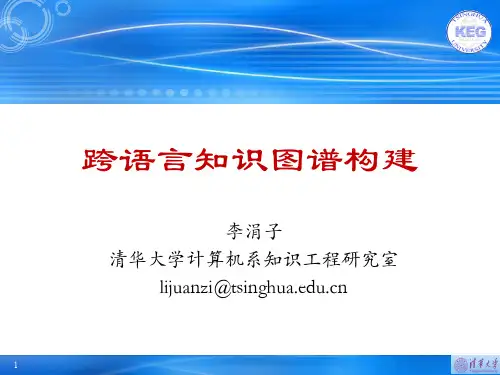

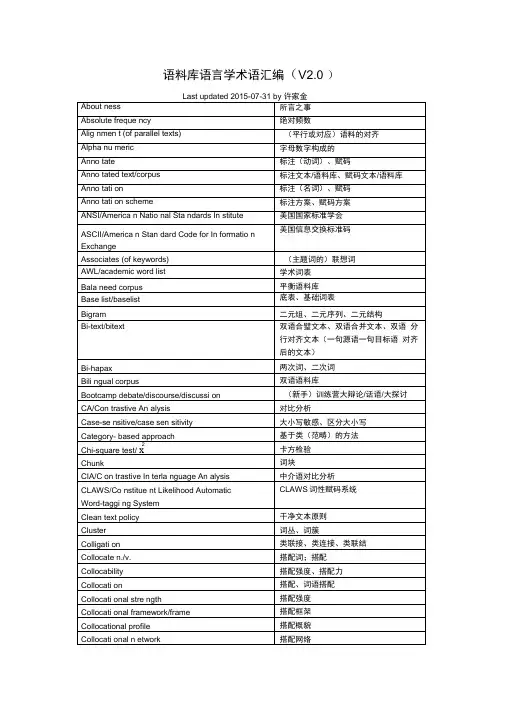
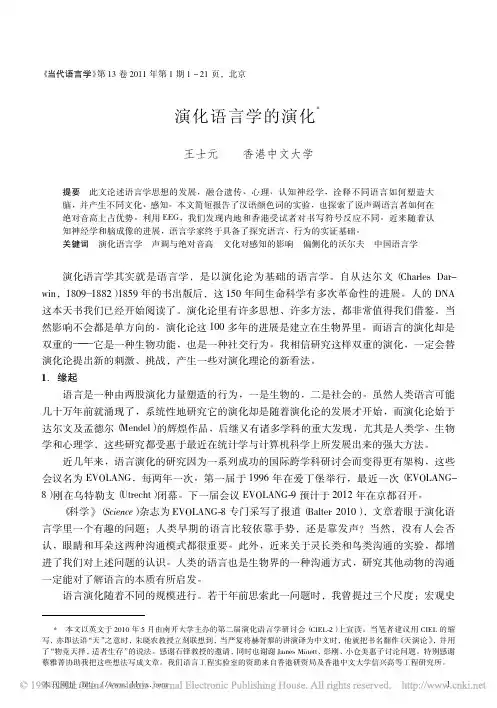
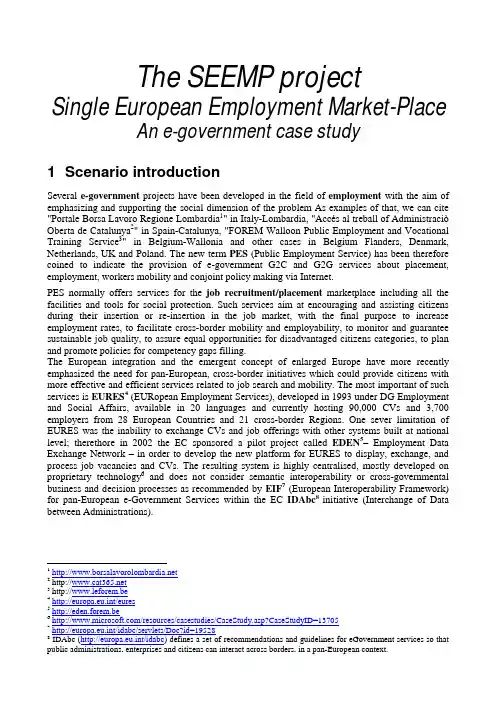
The SEEMP projectSingle European Employment Market-PlaceAn e-government case study1 Scenario introductionSeveral e-government projects have been developed in the field of employment with the aim of emphasizing and supporting the social dimension of the problem As examples of that, we can cite "Portale Borsa Lavoro Regione Lombardia1" in Italy-Lombardia, "Accés al treball of Administraciò Oberta de Catalunya2" in Spain-Catalunya, "FOREM Walloon Public Employment and Vocational Training Service3" in Belgium-Wallonia and other cases in Belgium Flanders, Denmark, Netherlands, UK and Poland. The new term PES (Public Employment Service) has been therefore coined to indicate the provision of e-government G2C and G2G services about placement, employment, workers mobility and conjoint policy making via Internet. PES normally offers services for the job recruitment/placement marketplace including all the facilities and tools for social protection. Such services aim at encouraging and assisting citizens during their insertion or re-insertion in the job market, with the final purpose to increase employment rates, to facilitate cross-border mobility and employability, to monitor and guarantee sustainable job quality, to assure equal opportunities for disadvantaged citizens categories, to plan and promote policies for competency gaps filling. The European integration and the emergent concept of enlarged Europe have more recently emphasized the need for pan-European, cross-border initiatives which could provide citizens with more effective and efficient services related to job search and mobility. The most important of such services is EURES4 (EURopean Employment Services), developed in 1993 under DG Employment and Social Affairs, available in 20 languages and currently hosting 90,000 CVs and 3,700 employers from 28 European Countries and 21 cross-border Regions. One sever limitation of EURES was the inability to exchange CVs and job offerings with other systems built at national level; therethore in 2002 the EC sponsored a pilot project called EDEN5– Employment Data Exchange Network – in order to develop the new platform for EURES to display, exchange, and process job vacancies and CVs. The resulting system is highly centralised, mostly developed on proprietary technology6 and does not consider semantic interoperability or cross-governmental business and decision processes as recommended by EIF7 (European Interoperability Framework) for pan-European e-Government Services within the EC IDAbc8 initiative (Interchange of Data between Administrations). 3 http://www.leforem.be 4 http://europa.eu.int/eures 5 http://eden.forem.be 6 /resources/casestudies/CaseStudy.asp?CaseStudyID=13705 7 http://europa.eu.int/idabc/servlets/Doc?id=19528 8 IDAbc (http://europa.eu.int/idabc) defines a set of recommendations and guidelines for eGovernment services so that public administrations, enterprises and citizens can interact across borders, in a pan-European context.212 The SEEMP projectSEEMP (Single European Employment Market-Place) is a EU-funded project kicking-off in January 2006. SEEMP mission is to design and implement in a prototypal way an interoperability architecture for public e-Employment services which encompasses cross-governmental business and decisional processes, interoperability and reconciliation of local professional profiles and taxonomies, semantically enabled web services for distributed knowledge access and sharing. The resulting ICT networked system should overcome most of the limitations present in current regional and national e-placement solutions, such as limited cross-government administrative processes interconnection and synchronization, limited cross-border knowledge and information circulation, scarce data and applications interoperability, semantic heterogeneity both at the administrative norms and classifications and at the technological level, not coordinated job policy strategies and principles, creating the premises for building a Single European Employment Market, in which PA networked bodies will play the fundamental role of arbiters and mediators between citizens, employment agencies and enterprises. In particular, the SEEMP project will develop an EIF-compliant federated architecture and interoperability middleware as well as applicative plug-in services to allow existing National/Local job market places and data warehouses to be interoperable at pan-European level by overcoming state-of-the-art limitations: • from an organizational viewpoint, by implementing cross-governmental business and decision processes and supporting them with proper ICT tools for their design and enactment (EIF CGBM functions); • from a semantic viewpoint, by implementing cross-governmental ontology, semantic annotation tools and ontology reconciliation mechanisms (EIF CG-OM functions); • from a technical viewpoint, by implementing a cross-governmental service-oriented architecture following the WSMO9 (Web Service Modelling Ontology) approach. On top of this ICT interoperability infrastructure, SEEMP will develop knowledge discoverymining services for cross-governmental decision and policy making support (EIF CG-DS).3 Case Study overviewPESs are information intermediaries between job seekers and employers. The existing Public Employment Services differ substantially in the way they describe positioning regarding to geographical areas, specific industries or occupation groups. As a conseguence many standards are adopted and each online portal normally uses different classifications. Offering an homogeneous view upon such numerous and heterogeneous portals is almost impossible. From the viewpoint of an organization a typical recruitment process can be divided into four main phases: 1. describing the requirements of the job position, 2. publishing the job posting, 3. receiving of applications, and 4. final decision making.9The following figure shows in a simplified manner a typical existing PES where users (Citizens, Agencies and Employers) access to the local repositories and functionalities through dedicated GUIs.Figure 1: a typical existing PESNowadays, job postings/CVs are written in free text (i.e. rarely choosing term from controlled vocabulary) and are shared among PESs using proprietary mechanisms, thus making very difficult both searching and exchanging them at a pan-European scale. In order to overcome such limitations SEEMP will employ Semantic Web Services technology by semantically annotating both the services for interacting with a PES and the job offerings/CVs. Therefore, in SEEMP, an open position/CV published on a PES will be made available to all the other PESs. This would allow job seekers to select one single portal and to access all information available in the market.PESPESPESReference Ontology PES PESSEEMP peerPESPESLocal Ontology Semantic Web Services MediatorsFigure 2: Semantic Web Services technology used to integrate existing PES in a pan-European networked systemUsing Semantic Web Services Technologies to integrate PES (hence enabling distribute job postings) will increase market transparency and, in the meantime, will avoid the bottleneck of a central database. Organizations will publish annotated job postings directly on their websites usingterms taken from a set of controlled vocabularies (defined by a set of ontologies). They will make it possible to search and retrieve them via Web Services, so that the centralized approach will be replaced by a distributed approach. Consequently, all job portals will operate on the same information and postings would reach more applicants, resulting in a higher market transparency. The core component of the system will be a Reference Ontology which will foster as much as possible the usage of a common "language" in the form of a set of controlled vocabularies to describe the details of a job posting and the related Web Services. This Reference Ontology will facilitate communication between all parties involved and will open up the potential of the automation of various tasks within the process. In order to preserve a high degree of autonomy in the organization interconnected by SEEMP solution, each organization could also independently maintain a Local Ontology and the necessary mediation services for maintaining the local ontologies aligned with the Reference Ontology.4 Envisioned architectureThe SEEMP architecture will be an interoperability infrastructure for Public Employment Services based on Semantic enabled Web Services. The following picture represents an early-proposal of the internal architecture of a single node (SEEMP peer) of the SEEMP Networked System:PES Manager/ AdministratorCitizens Agencies EmployersSEEMP PeerSEEMP Support ToolsExisting PESMultiChannel Service DeliverySEEMP RepositoryPolicy Management DSSQuality Driven Query Answering Semantic Content Annotation Collaborative Business ProcessLocal OntologiesSEEMP Interoperability FrameworkReference OntologyData CleansingOrchestrationGoal DescriptionsDiscoveryCommunicationInvocationWS descriptionsData Mediation / Ontology ReconciliationLocal-to-Reference Ontology MediatorsFigure 1: SEEMP peer internal architectureA SEEMP peer acts as an extension framework for an existing PES. A SEEMP peer will be capable of providing policy-management-based DSS, Quality Driven Query answering, Semantic interoperability features and Collaborative Business Process tools. A SEEMP peer will be made up by three main internal parts: • SEEMP Repository: it’s responsible for storing information needed to perform the required features. In particular it manages Local and Reference ontologies, which will containvocabularies and taxonomies that describe jobs, organizations, application details and skills. Human resource ontologies need to be created by integrating existing standards. The repository handles the necessary mediators for translating Job Offers and Demands from Local ontologies to the Reference ontology, and vice versa. Moreover, the SEEMP repository handles Goal and Web Service description built-up on market data in order to perform demanded discovery and composition tasks. In any case, Job-Offers and Demands owned by the existing PESs are NOT replicated inside this repository in order to avoid ownerships problems between PESs. • SEEMP Interoperability Framework: it contains the main components that perform the core features of the SEEMP Networked System. o Data Cleansing manages the consolidation of data among PES databases by removing inconsistent data and re-indexing existing data in order to maintain accurate and concise databases. o Discovery performs semantic discovery and location of information providers within the SEEMP Networked System using the Goal and Web Service descriptions stored in the repository. This component uses Semantic matching algorithms to match applicant profiles and job postings based on the knowledge included in the ontology and the available descriptions. o Orchestration and Communication-Invocation enable the features related to collecting data from different providers and performing business processes between peers and existing public National or local job market places. o Data Mediation/Ontology Reconciliation handles the activities related to integrate data published using different vocabularies in a common Reference Ontology. SEEMP Support Tools: users will take advantage of these tools to interact with the SEEMP Networked System to obtain the enhanced features. These tools can be mainly distinguished in: o Policy Management DSS: a decision and policy making support that will integrate innovative indicators for employability, job quality management and competencies planning and improvement. o Quality Driven Query Answering: this module will support user to evaluate the correctness and rank answers by means of quality based mechanisms. Queries over databases characterized by a poor quality of data often returns a set of different (equivalent) answers that need to be compared and ranked. A technique to address this issue is to associate each answer with a profile that states qualities such as correctness, cost, trustworthiness, and other parameters. Such a technique can be improved by using the Reference Ontology and semantic annotations. o Semantic Content Annotation: the domain specific knowledge will be represented in the form of various concept hierarchies (skills, occupation classification, industry sectors, etc.) and will be used to determine the semantic similarity between concepts. The ontology will provide means for semantic annotation of job postings and job applications. Using controlled vocabularies, in contrast to free text descriptions will result in a better machine processability, data interoperability and integration. Moreover, describing job position postings and job position seekers using controlled vocabulary from ontology will allow for performing semantic matching, i.e. the calculation of the degree of semantic similarity between an applicant profile and job requirements. Consequently, for a given job position a ranked list of the best matching candidates can be delivered as a result, and vice versa. o Collaborative Business Processes: a process model will implement the typical job search, job offer and administrative tasks under strict and precise privacy constraints.•。
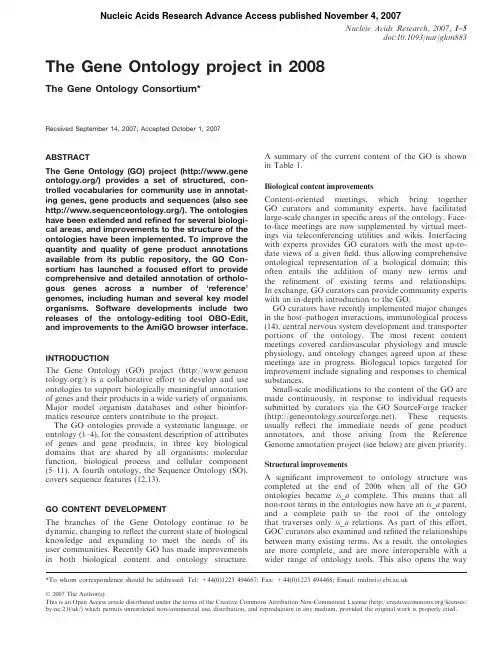
Nucleic Acids Research,2007,1–5doi:10.1093/nar/gkm883The Gene Ontology project in2008The Gene Ontology Consortium*Received September14,2007;Accepted October1,2007ABSTRACTThe Gene Ontology(GO)project(http://www.gene /)provides a set of structured,con-trolled vocabularies for community use in annotat-ing genes,gene products and sequences(also see /).The ontologies have been extended and refined for several biologi-cal areas,and improvements to the structure of the ontologies have been implemented.To improve the quantity and quality of gene product annotations available from its public repository,the GO Con-sortium has launched a focused effort to provide comprehensive and detailed annotation of ortholo-gous genes across a number of‘reference’genomes,including human and several key model organisms.Software developments include two releases of the ontology-editing tool OBO-Edit, and improvements to the AmiGO browser interface. INTRODUCTIONThe Gene Ontology(GO)project(http://www.geneon /)is a collaborative effort to develop and use ontologies to support biologically meaningful annotation of genes and their products in a wide variety of organisms. Major model organism databases and other bioinfor-matics resource centers contribute to the project.The GO ontologies provide a systematic language,or ontology(1–4),for the consistent description of attributes of genes and gene products,in three key biological domains that are shared by all organisms:molecular function,biological process and cellular component (5–11).A fourth ontology,the Sequence Ontology(SO), covers sequence features(12,13).GO CONTENT DEVELOPMENTThe branches of the Gene Ontology continue to be dynamic,changing to reflect the current state of biological knowledge and expanding to meet the needs of its user communities.Recently GO has made improvements in both biological content and ontology structure.A summary of the current content of the GO is shown in Table1.Biological content improvementsContent-oriented meetings,which bring together GO curators and community experts,have facilitated large-scale changes in specific areas of the ontology.Face-to-face meetings are now supplemented by virtual meet-ings via teleconferencing utilities and wikis.Interfacing with experts provides GO curators with the most up-to-date views of a givenfield,thus allowing comprehensive ontological representation of a biological domain;this often entails the addition of many new terms and the refinement of existing terms and relationships. In exchange,GO curators can provide community experts with an in-depth introduction to the GO.GO curators have recently implemented major changes in the host–pathogen interactions,immunological process (14),central nervous system development and transporter portions of the ontology.The most recent content meetings covered cardiovascular physiology and muscle physiology,and ontology changes agreed upon at these meetings are in progress.Biological topics targeted for improvement include signaling and responses to chemical substances.Small-scale modifications to the content of the GO are made continuously,in response to individual requests submitted by curators via the GO SourceForge tracker ().These requests usually reflect the immediate needs of gene product annotators,and those arising from the Reference Genome annotation project(see below)are given priority. Structural improvementsA significant improvement to ontology structure was completed at the end of2006when all of the GO ontologies became is_a complete.This means that all non-root terms in the ontologies now have an is_a parent, and a complete path to the root of the ontology that traverses only is_a relations.As part of this effort, GOC curators also examined and refined the relationships between many existing terms.As a result,the ontologies are more complete,and are more interoperable with a wider range of ontology tools.This also opens the way*To whom correspondence should be addressed:Tel:+44(0)1223494667;Fax:+44(0)1223494468;Email:midori@ß2007The Author(s)This is an Open Access article distributed under the terms of the Creative Commons Attribution Non-Commercial License(/licenses/ by-nc/2.0/uk/)which permits unrestricted non-commercial use,distribution,and reproduction in any medium,provided the original work is properly cited.Nucleic Acids Research Advance Access published November 4, 2007to more advanced reasoning,and moreflexible ontology visualization.GO(and SO)curators use OBO-Edit(15),a Java-based ontology editor,to maintain and improve the ontologies. The most recent version of OBO-Edit offers sophisticated filtering,editing,reasoning and error-checking capabilities with both GUI and command-line access.Built-in checks in OBO-Edit help maintain ontology structure,ensuring that curators correctly format definitions and maintain complete is_a paths.Other computational checks generate reports thatflag possible logical inconsistencies in the ontologies for examination and resolution by GOC curators.The reasoner in OBO-Edit takes advantage of the increased expressive power of the new OBO Format1.2 specification(/GO.format. obo-1_2.shtml).Using OBO Format 1.2,the GO can now provide ontology subsets(‘GO slims’)and metadata term obsoletion(e.g.alternative terms to update annota-tions).The format also supports anticipated new features such as cross-products,multi-species interactions (e.g.host–pathogen interactions)and homologous gene sets.The new specification also supports GO’s current focus on offering improved support for biochemical pathways by appropriately linking the three branches of the GO.There is also ongoing work specifying cross-products that forge links between the GO and other ontologies in the Open Biomedical Ontologies(OBO) Foundry(/)collection.THE SEQUENCE ONTOLOGYThe Sequence Ontology continues to provide the termi-nology needed to describe biological sequences,with the aim of unifying sequence annotation(13).SO has been adopted by many model organism databases as it forms the basis for sequence feature annotation by the Chado database schema(16)and the GFF3(http://www.sequenc /gff3.shtml)sequence annotation format. The ontology now contains over1300terms,161of which are cross-products;the latter are new terms that are intersections between a sequence feature and a sequence attribute.For example,low_complexity_region (SO:0001005)is explicitly defined as a region(SO:0000001) that has the characteristic of low sequence complexity. SO held two workshops in2006covering topics ranging from mobile genetic elements to RNA editing and mammalian immunology,thereby meeting the needs of diverse users.SO has also actively collaborated with other ontology and database groups to develop and incorporate new terminology.For example,SO recently added96 protein-based features to the ontology after working with the Biosapiens group(17).New terms can also be requested via a SourceForge tracker or the developers’mailing list.IMPROVING ANNOTATION COVERAGEThe Reference Genome annotation projectIn early2006,the GO Consortium initiated the Reference Genome project,whose purpose is to offer comprehensive GO annotation for a varied group of organisms: Arabidopsis thaliana(thale cress),Caenorhabditis elegans (nematode),Danio rerio(zebrafish),Dictyostelium discoideum(slime mold),Drosophila melanogaster(fruit fly),Escherichia coli,Gallus gallus(chicken),Homo sapiens (human),Mus musculus(mouse),Rattus norvegicus(rat), Saccharomyces cerevisiae(baker’s yeast)and Schizosaccharomyces pombe(fission yeast)(Gene Ontology Reference Genome group,manuscript in pre-paration).These organisms were chosen because they form an experimentally studied,biologically and evolu-tionarily diverse group for which expert curators are available to ensure accurate and consistent genome prehensiveness of annotation is mea-sured by how many genes in a genome are annotated (breadth)and how completely those annotations capture known functions(depth).The standards of annotations of the Reference Genome groups are high:measures of comprehensiveness count only annotations based directly on experimental data and those based upon manual inspection of sequence similarity to an experimentally characterized target.The current targets for annotation are human genes associated with heritable diseases and their orthologs(or similar genes)in the other genomes. Figure1shows a selection of the molecular function GO terms used to annotate human MSH2and its orthologs; the complete graph is available as Supplementary Data. The Reference Genome project will eventually extend its annotation targets beyond the initial focus on disease genes,and will refine annotation metrics,ortholog identification and public access to annotations. Annotation of reference genes helps determine ontology development priorities,such that any new terms needed are added to the ontology promptly.A significant expected benefit of the high quality annotation set provided by the Reference Genome group is to assist annotation in other species,especially for newly sequenced genomes. Supporting new annotation groupsThe GO Consortium has continued to actively support the use of GO to annotate emerging genomes,by offering annual annotation camps and one-to-one mentoring to new groups.Several new annotation groups have joined the GO project in the past two years,including AgBase (/;(18)),Muscle TRAITTable1.Status of GO,September1,2007Biological process terms13916 Molecular function terms7878 Cellular component terms2007 Sequence ontology terms1305 Annotation datasets a35 Species with annotation137454 Annotated gene productsTotal3347495 Electronic3128309 Manual219186 a Most datasets represent single species;Gramene,the TIGR gene index, UniProt GOA and UniProt PDB represent multiple species.2Nucleic Acids Research,2007(http://muscle.cribi.unipd.it/),and the Plant-Associated Microbe Gene Ontology (/)group.The GO Consortium has also supported a number of new community annotation efforts.In 2006,the Eurofung group (/)held a community annotation meeting,during which biologists provided manual GO annotation for approximately 500gene products.GO has,in addition,set up a community annotation wiki to allow experimental immunologists to contribute annotations (see /GO.immunology.shtml).USER SUPPORT AND AVAILABILITYThe GO Consortium has initiated a coordinated effort to establish lines of communication between itself and users of the ontologies and annotations in the scientific community to ensure that the Consortium remains aware of,and receptive to,the community’s needs.A quarterly newsletter is now produced to communicate current and future developments within the GO Consortium;in addition,the GO Newsletter features uses of GO within the scientific community in its ‘Paper Review’and provides tips for using OBO-Edit or AmiGO.The newsletter can be viewed online (http://www.geneon /newsletter/current-newsletter.shtml)or by sub-scribing to the GO-friends mailing list.The AmiGO browser (now at http://amigo.geneonto ),a web-based tool for searching GO terms and annotations,has been enhanced by the addition of new navigation and search options,an improved display of search results,and a simplified user interface.Advanced users have the option to query any of several GO database SQL mirrors programatically or via the GO Online SQL Environment (GOOSE)interface (http://www.berkeley /goose);the latter includes a collectionofFigure 1.A selection of annotations curated by GO Reference Genome project annotators for human MSH2and its predicted orthologs.GO terms are depicted graphically,with arrows representing relationships between terms;each term includes color-coded panels representing the species in which an ortholog has been annotated to the term.Nucleic Acids Research,20073user-adaptable templates for common queries.GO also offers semantic web access to the database via an experimental SPARQL(/TR/rdf-sparql-query/)EndPoint.URLs and database access details are available as Supplementary Data.The GO and SO are available in both OBO and OWL formats and can be browsed online using AmiGO and miSO,respectively.GO annotations are available in their native tab-delimited format and as RDF-XML and a MySQL database dump.URLs for downloads and documentation are available as Supplementary Data. Please do not hesitate to contact GO at gohelp@gene with comments,questions or suggestions about any GO resources,or enquiries about contributing GO annotations.SUPPLEMENTARY DATASupplementary Data are available at NAR Online.ACKNOWLEDGEMENTSThe Gene Ontology Consortium is supported by National Human Genome Research Institute(NHGRI)grant HG02273.GO Consortium member databases receive funding from several National Institutes of Health institutes(NHGRI,National Institute of Child Health and Human Development,National Heart,Lung,and Blood Institute,National Institute of General Medical Sciences)and by the National Science Foundation,the United States Department of Agriculture Cooperative State Research and Education Service and the UK Medical Research Council.The GO Consortium also thanks the community researchers who have participated in content-related meetings or provided valuable feedback on ontology content and annotations.Funding to pay the Open Access publication charges for this article was provided by NHGRI.Conflict of interest statement.None declared.REFERENCES1.Gruber,T.R.(1993)A translation approach to portable ontologyspecifications.Knowl.Acq.,5,199–220.2.Jones,D.M.and Paton,R.(1999)Toward principles for therepresentation of hierarchical knowledge in formal ontologies.Data Knowl.Eng.,31,99–113.3.Stevens,R.,Goble,C.A.and Bechhofer,S.(2000)Ontology-basedknowledge representation for bioinformatics.Brief.Bioinform.,1, 398–414.4.Schulze-Kremer,S.(2002)Ontologies for molecular biology andbioinformatics.In Silico Biol.,2,179–193.5.The Gene Ontology Consortium(2000)Gene Ontology:tool for theunification of biology.Nat.Genet.,25,25–29.6.The Gene Ontology Consortium(2001)Creating the Gene Ontologyresource:design and implementation.Genome Res.,11,1425–1433.7.Blake,J.A.and Harris,M.A.(2003)The Gene Ontology project:structured vocabularies for molecular biology and their application to genome and expression analysis.In Baxevanis,A.D.,Davison,D.B.,Page,R.D.M.,Petsko,G.A.,Stein.,L.D.andStormo,G.(eds),Current Protocols in Bioinformatics,John Wiley& Sons,New York.8.The Gene Ontology Consortium(2004)The Gene Ontology(GO)database and informatics resource.Nucleic Acids Res.,32,D258–D261.9.Harris,M.A.,Lomax,J.,Ireland,A.and Clark,J.I.(2005)The GeneOntology project.In Subramaniam,S.(ed),Encyclopedia ofGenetics,Genomics,Proteomics and Bioinformatics,John Wiley& Sons,New York.10.Lewis,S.E.(2005)Gene Ontology:looking backwards and forwards.Genome Biol.,6,103.11.The Gene Ontology Consortium(2006)The Gene Ontology(GO)project in2006.Nucleic Acids Res.,34,D322–D326.12.Eilbeck,K.and Lewis,S.E.(2004)Sequence Ontology annotationpar.Funct.Genom.,5,642–647.13.Eilbeck,K.,Lewis,S.E.,Mungall,C.J.,Yandell,M.,Stein,L.,Durbin,R.and Ashburner,M.(2005)The SequenceOntology:a tool for the unification of genome annotations.Genome Biol.,6,R44.14.Diehl,A.D.,Lee,J.A.,Scheuermann,R.H.and Blake,J.A.(2007)Ontology development for biological systems:immunology.Bioinformatics,23,913–915.15.Day-Richter,J.,Harris,M.A.,Haendel,M.and Lewis,S.(2007)OBO-Edit–an ontology editor for biologists.Bioinformatics,23, 2198–2200.16.Mungall,C.J.and Emmert,D.B.and the FlyBase Consortium(2007)A Chado case study:an ontology-based modular schema forrepresenting genome-associated biological information.Bioinformatics,23,i337–i346.17.Reeves,G.A.and Thornton,J.M.(2006)Integrating biologicaldata through the genome.Hum.Mol.Genet.,15(Spec No.1),R81–R87.18.McCarthy,F.M.,Bridges,S.M.,Wang,N.,Magee,G.B.,Williams,W.P.,Luthe,D.S.and Burgess,S.C.(2007)AgBase:aunified resource for functional analysis in agriculture.NucleicAcids Res.,35,D599–D603.APPENDIXMidori A.Harris,Jennifer I.Deegan(ne e Clark),Amelia Ireland,Jane Lomax(GO-EBI,Hinxton,UK);Michael Ashburner,Susan Tweedie(FlyBase,Department of Genetics,University of Cambridge,Cambridge,UK); Seth Carbon,Suzanna Lewis,Chris Mungall,John Day-Richter(BBOP,LBNL,Berkeley,CA,USA),Karen Eilbeck(Eccles Institute of Human Genetics,University of Utah,Salt Lake City,UT,USA),Judith A.Blake, Carol Bult,Alexander D.Diehl,Mary Dolan,Harold Drabkin,Janan T.Eppig,David P.Hill,Li Ni,Martin Ringwald(MGI,The Jackson Laboratory,Bar Harbor, ME,USA);Rama Balakrishnan,Gail Binkley,J.Michael Cherry,Karen R.Christie,Maria C.Costanzo,Qing Dong,Stacia R.Engel,Dianna G.Fisk,Jodi E. Hirschman,Benjamin C.Hitz,Eurie L.Hong,Cynthia J.Krieger,Stuart R.Miyasato,Robert S.Nash,Julie Park,Marek S.Skrzypek,Shuai Weng,Edith D.Wong, Kathy K.Zhu(SGD,Department of Genetics,Stanford University,Stanford,CA,USA);David Botstein,Kara Dolinski,Michael S.Livstone,Rose Oughtred(Lewis-Sigler Institute for Integrative Genomics,Princeton University,Princeton,NJ,USA);Tanya Berardini, Donghui Li,Seung Y.Rhee(TAIR,Carnegie Institution,Department of Plant Biology,Stanford,CA, USA);Rolf Apweiler,Daniel Barrell,Evelyn Camon, Emily Dimmer,Rachael Huntley,Nicola Mulder(GOA Database,UniProt,EBI,Hinxton,UK);Varsha K.Khodiyar,Ruth C.Lovering,Sue Povey(UCL, London,UK);Rex Chisholm,Petra Fey,Pascale4Nucleic Acids Research,2007Gaudet,Warren Kibbe(dictyBase,Northwestern University,Chicago,IL,USA);Ranjana Kishore,Erich M.Schwarz,Paul Sternberg,Kimberly Van Auken (WormBase,California Institute of Technology, Pasadena,CA,USA);Michelle Gwinn Giglio,Linda Hannick,Jennifer Wortman(The J.Craig Venter Institute,Rockville,MD,USA);Martin Aslett,Matthew Berriman,Valerie Wood(Wellcome Trust Sanger Institute,Hinxton,UK);Howard Jacob,Stan Laulederkind,Victoria Petri,Mary Shimoyama,Jennifer Smith,Simon Twigger(RGD,Medical College of Wisconsin,Milwaukee,WI,USA);Pankaj Jaiswal (Gramene,Department of Plant Breeding,Cornell University,Ithaca,NY,USA);Trent Seigfried (MaizeGDB,UDSA-ARS,Ames,IA,USA);Doug Howe,Monte Westerfield(ZFIN,University of Oregon, Eugene,OR,USA);Candace Collmer(PAMGO,Wells College,Aurora,NY,USA);Trudy Torto-Alalibo (PAMGO,Virginia Bioinformatics Institute,VA,USA); Erika Feltrin,Giorgio Valle(CRIBI,University of Padua, Italy);Susan Bromberg,Shane Burgess,Fiona McCarthy (AgBase,Mississippi State University;MS,USA).Nucleic Acids Research,20075。
CollaborativeandUsage-drivenEvolutionofPersonalOntologiesPeterHaase1andAndreasHotho2andLarsSchmidt-Thieme3andYorkSure11InstituteAIFBUniversityofKarlsruhe,Germany{ysu,pha}@aifb.uni-karlsruhe.de2KnowledgeDiscoveryEngineeringGroup(KDE)UniversityofKassel,Germanyhotho@cs.uni-kassel.de3Computer-basedNewMediaGroup(CGNM)
InstituteforComputerScienceUniversityofFreiburg,Germanylst@informatik.uni-freiburg.de
AbstractLargeinformationrepositoriesasdigitalli-braries,onlineshops,etc.relyonataxonomyoftheobjectsunderconsiderationtostructurethevastcontentsandfacilitatebrowsingandsearch-ing(e.g.,ACMtopicclassificationforcomputerscienceliterature,Amazonproducttaxonomy,etc.).Asinheterogenouscommunitiesuserstyp-icallywillusedifferentpartsofsuchanontologywithvaryingintensity,customizationandperson-alizationoftheontologiesisdesirable.Ofpartic-ularinterestforsupportingusersduringtheper-sonalizationarecollaborativefilteringsystemswhichcanproducepersonalrecommendationsbycomputingthesimilaritybetweenownpref-erencesandtheoneofotherpeople.Inthispaperweadaptacollaborativefilteringrecommendersystemtoassistusersinthemanagementandevolutionoftheirpersonalontologybyprovidingdetailedsuggestionsofontologychanges.SuchasystemhasbeenimplementedinthecontextofBibster,apeer-to-peerbasedpersonalbibli-ographymanagementtool.Finally,wereportonanexperimentwiththeBibstercommunitythatshowstheperformanceimprovementsovernon-personalizedrecommendations.1
1IntroductionLargeinformationrepositoriesasdigitallibraries,onlineshops,etc.relyonataxonomyoftheobjectsunderconsid-erationtostructurethevastcontentsandfacilitatebrows-ingandsearching(e.g.,ACMTopicHierarchyforcom-puterscienceliterature,Amazonproducttaxonomy,etc.).Asinheterogenouscommunitiesuserstypicallywillusedifferentpartsofsuchanontologywithvaryingintensity,customizationandpersonalizationoftheontologiesisde-sirable.Suchpersonalontologiesreflecttheinterestsofusersatcertaintimes.Interestsmightchangeaswellastheavail-abledata,thereforethepersonalizationrequiresquitenatu-rallysupportfortheevolutionofpersonalontologies.Thesheersizeofe.g.theACMTopicHierarchymakesitquitedifficultforuserstoeasilylocatetopicswhicharerelevantforthem.Oftenonecanbenefitfromhavingacommu-nityofuserswhichallowsforrecommendingrelevanttop-icsaccordingtosimilarinterests.Ofparticularinterestarethereforecollaborativefilteringsystemswhichcanproduce
1ThisworkwasalsopresentedatESWC2005.
personalrecommendationsbycomputingthesimilaritybe-tweenownpreferencesandtheoneofotherpeople.WeperformedourevaluationwithintheBibstercommu-nity.Bibsterisasemantics-basedPeer-to-Peerapplicationaimingatresearcherswhowanttobenefitfromsharingbib-liographicmetadata.Itenablesthemanagementofbiblio-graphicmetadatainaPeer-to-Peerfashion:itallowstoim-portbibliographicmetadata,e.g.fromBIBTEXfiles,intoalocalknowledgerepository,toshareandsearchtheknowl-edgeinthePeer-to-Peersystem,aswellastoeditandex-portthebibliographicmetadata.Asourmaincontributioninthispaperweadaptacollab-orativefilteringrecommendersystemtoassistusersinthemanagementandevolutionoftheirpersonalontologybyprovidingdetailedsuggestionsofontologychanges.TheapproachisimplementedasanextensionoftheBibsterapplicationandhasbeenthoroughlyevaluatedwithverypromisingresults.Thepaperisstructuredasfollows.InthenextSec-tion2wepresentrelatedworkintheareasofworkinrec-ommendersystems,workinusingtaxonomiesinrecom-mendersystems,andworkinlearningtaxonomiesandon-tologyevolutioningeneral.InSection3wedescribeourunderlyingontologymodelwhichisbasedonOWL,thechangeoperationsusedduringtheevolutionofontologies,andtheontologyratingannotationsallowingeachusertoexpressmorefine-grainedtheimportanceofcertainontol-ogyparts.Therecommendermethoditselfanditsfunction-alityisillustratedinSection4.WewillintroducetheBib-sterapplicationsanditsextensionswiththerecommenderfunctionalityinSection5followedbyevaluationresultsinSection6.Theevaluationwasperformedasanexper-imentwithintheBibstercommunityandshowstheperfor-manceimprovementsovernon-personalizedrecommenda-tions.Finally,weconcludeinSection7.
2RelatedWorkRelatedworkexistsinthreedifferentaspects:workinrecommendersystems,especiallycollaborativefilteringingeneral,workinusingtaxonomiesinrecommendersys-tems,andworkinlearningtaxonomiesandontologyevo-lutioningeneral.Recommendersystemshavetheirrootsinrelevancefeedbackininformationretrieval[Salton,1971],i.e.,addingtermsto(queryexpansion)orre-weightingtermsof(termre-weighting)aquerytoadocumentrepositorybasedontermsindocumentsintheresultsetoftheorig-inalquerythathavebeenmarkedrelevantornon-relevantbytheuser,aswellasadaptivehypertextandhypermedia[StottsandFuruta,1991],i.e.,theautomaticadaptationof